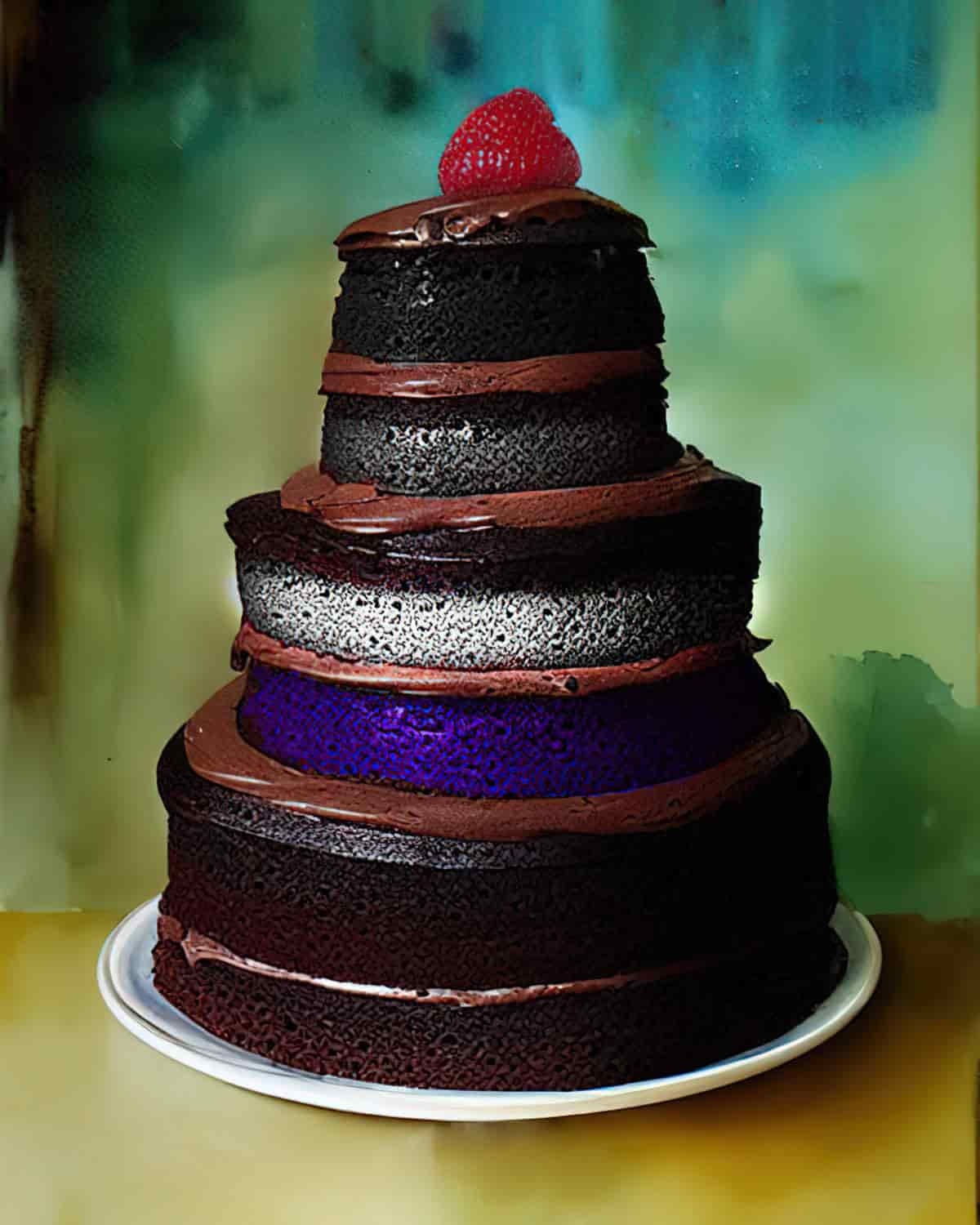You don’t understand people until you understand sexuality. And you don’t understand sexuality until you understand asexuality. Asexuality is not an absence of sexuality. Rather it is a ‘self-contained sexuality’, and might be defined as this:
Asexuality: Low to no sexual attraction and/or desire.
Asexuality is the A of the LGBTQIA+. (The A started out meaning ‘allies’, but doesn’t mean that anymore.) Asexuality is a type of queerness, though not all aces (asexual people) identify with the term queer. A huge proportion of the ace community are also genderqueer, non-binary or trans.
If you read the following books you will not only be an expert in asexuality, but you will also have your mind broadened where you never expected it to be broadened. You will learn about:
- The hugely nuanced definition of asexuality, how very broad it is, and why the asexual population is very likely much higher than the oft-touted one per cent.
- How the world around you has shaped your own sexuality (whatever that may be), sometimes beyond what you actually want or desire
- How sexuality and gender has been colonised
- How capitalist white patriarchy has had a huge influence on how you think about sex
- What it really means to ‘have sex’
- A broadened definition of the word ‘erotic’
- You don’t have to have partnered sex to be considered a good, worthwhile person. It’s enough to simply be you in the world.
- How ableism intersects with sexuality
- How race intersects with sexuality
- The pressures on everyone who is not asexual (sometimes called allosexual), and how being asexual is actually kind of a superpower
- That everyone’s attraction works a little bit differently; aces simply offer a clear-cut example
- That attraction and desire are not the same thing at all
What all of these books have in common: They are therapeutic. Some of them are quite expensive as they are released by small presses or academic presses. (Some are much more affordable as an eBook.) But consider this: Together they provide hours and hours of valuable education, and are still far, far cheaper than therapy with a qualified professional, who may or may not be qualified in this.
The Invisible Orientation: An Introduction to Asexuality by Julie Sondra Decker (2015)
If you’re new to asexuality and can’t say for sure what it means, how it feels to be asexual, this one’s for you. Published in 2015, this is quite old in the field of queer studies, especially asexuality studies because so much has happened since then.
This book is available for free at the Trans Reads project, created by and for transgender people to openly access writing related to our communities. We believe education should be free and writing shouldn’t be behind a paywall. Transreads.org provides the opportunity to access, discuss, and distribute texts for free. (This makes sense, since many aroaces are also trans. A search for asexual texts at the Trans Reads project throws up the following results.)
The valuable thing about this book: It’s repetition. This is also the thing some reviewers find a little tedious, but if you’ve ever encountered people in real life who simply. can’t. get. that asexuality refers to orientation (is not a choice, does not mean you’ve been sexually abused, does not mean you have never experienced pleasurable sex, that you don’t actually have to get your hormones checked), you will understand just how difficult many people find the entire concept of asexuality as a normal, healthy orientation.
This book is for those people who, let’s face it, probably won’t read it. It’s also available as an audiobook and the author (Swankivy on YouTube and elsewhere online) has been an ace activist for years, so there are plenty of places to hear her talk, aside from reading her book.
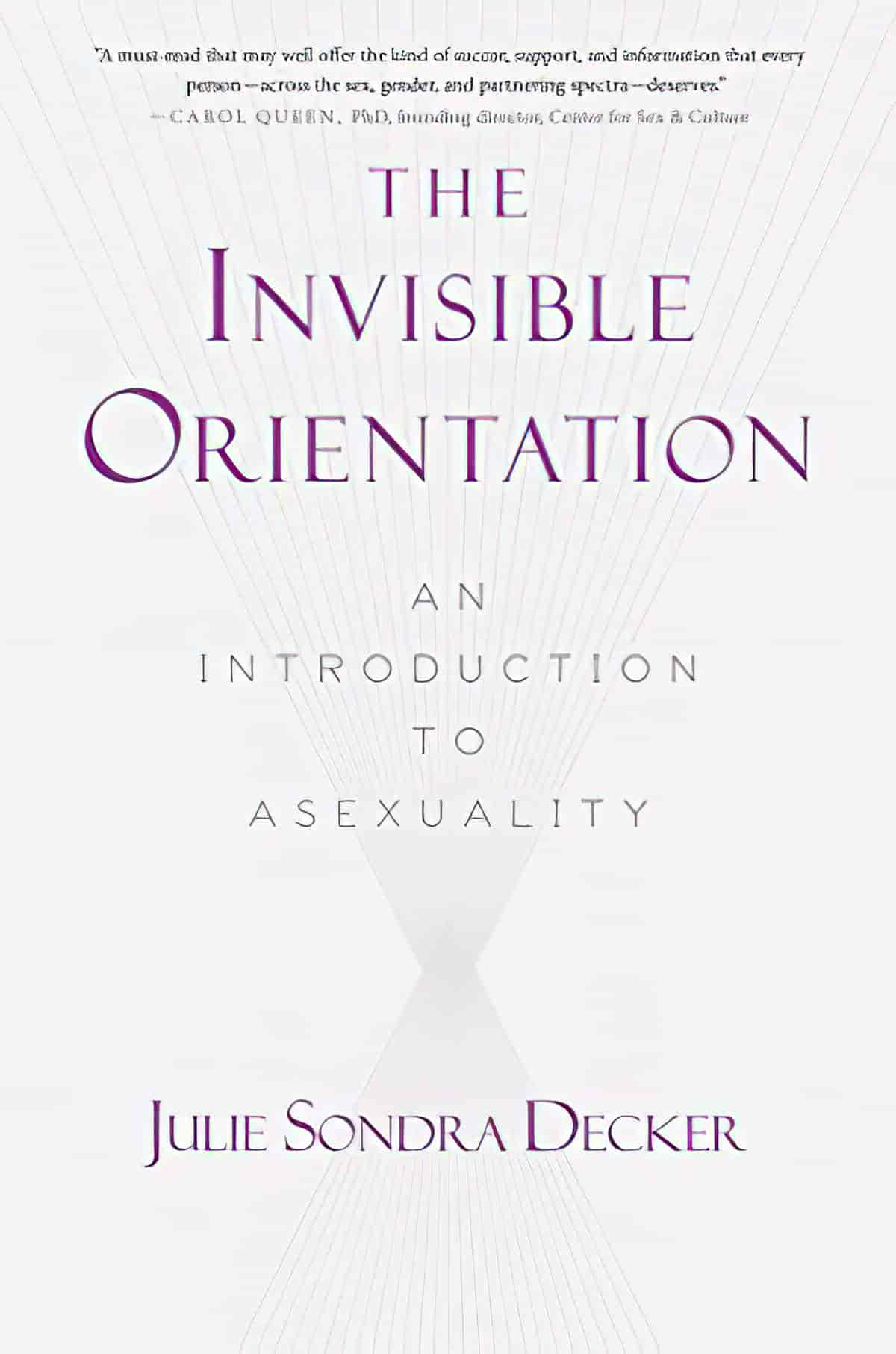
The Asexual Manifesto by Lisa Orlando (1972)
A landmark essay, lost for a long time, but now freely available online. The definition of asexuality has refined and moved on a little since this essay was written, but it remains an important historical document.
Even today, many asexuals prefer Orlando’s definition of asexuality because she positions it as an orientation in its own right, not as a lack:
“Asexual,” as we use it, does not mean “without sex” but “relating sexually to no one.” This does not of course exclude masturbation but implies that if one has sexual feelings, they do not require another person for their expression. Asexuality is, simply, self-contained sexuality.
The Asexual Manifesto by Lisa Orlando, 1972
Orlando also points out that sexual people frequently use sex as ‘a way of avoiding real closeness rather than achieving it’, which provides satisfying counterpoint to the naysayers who insist sex a prerequisite of emotional intimacy.
Where the essay feels dated: The conflation of sexual acts as exploitative and oppressive. Feminism has since developed a more sex positive and nuanced view of sexuality, (problematically, in fact, to the point where an active sex life is now a prerequisite of empowerment). This essay is interesting because it shows how that particular arc happened, and what compulsory sexuality is a response to.
I feel there’s another very good reason why it’s best to avoid defining asexuality as a lack, and it’s to do with the times we live in. The following transcript is not about asexuality at all, and in fact anyone who understands that orientation isn’t a choice/denial/decision will see the limitations of the analogy. But what people seem to have a really hard time understanding is that asexuality is not a denial of anything. That’s because we’ve got people like Gwyneth Paltrow to thank for creating a culture of what the following TikTok philosopher recognises as ’embodied denial’:
[There’s something] people are missing about Gwyneth Paltrow’s daily routine, her podcast in which she talked about her daily routine, and essentially revealed that she eats next to nothing. Now, I’ve already seen a lot of dietitians respond to this, and a lot of people have reacted in outrage saying how can you popularize on a celebrity platform distinctly unhealthy forms of behaviour that are then branded as being wellness? I’ve seen that already.
But to my mind, what immediately stood out from a psychoanalytic perspective is that here we have the perfect example of what Lacan deemed in characteristically slightly joking fashion: The problem that when you deny the body completely you thereby become denial embodied. Denial embodies the state that you exist in when you identify negatively.
That means of all the things that you don’t do, all the things that you’ve decided to withdraw from. Instead of identifying the things that you love doing, the things that you want to fight for, the things that fill your life with joy and meaning, your very identity has become a marker of negation, of negativity, of everything that you’ve withheld from yourself.
And this is actually like a cultural symptom that we see within contemporary society everywhere. Like you buy health food. Instead of telling you what’s in the health food, it tells you all the bad things that are not in it. Here we have the perfect example of negative identity that we identify, for example, with ethical consumption, not through what we’ve done or what we’ve bought, but what we’ve decided not to do or not to buy. And that thereby we exist in this very repressed form of life, whereby we think that we’re healthy, we think that we’re being good by means of denying ourselves the very things that make life beautiful and joyful and worth living.
And it’s almost painful to see that this is being advocated as a form of wellness because wellness isn’t saying I’ve reduced my life to a kind of marker of denial which Lacan called embodied denial. Instead, life is about embracing the beauty of joyful incremental self destruction.
As you move towards the inevitable end goal. And immortality therefore lies precisely not in trying to embalm your body in a kind of living death. Immortality lies within embracing the moment within this joyful leap of faith, as Kierkegaard once put it, into the embrace of everything that makes life worth living. And it makes me sad to see that this has become another way in which people identify as being healthy, by means of saying, here’s everything I don’t do. Here’s what I don’t eat. Here’s what I don’t drink. Whereas life and love should be about what you do do, what you believe in, what you embrace. You have to be willing to risk it all to do the things you love, and to imbue your life with meaning. I immediately thought of the Lacanian psychanalytic principle that the danger of denying the body is that you can become denial embodied and it’s sad to see that. But I also want to encourage people to live their life to the fullest.
Julian de Medeiros, @julianphilosophy on TikTok
I believe many thinking people understand that we are living in a culture of embodied denial — whether they know the terminology or not — and when asexuality is described to them as a lack of attraction, it is all too easy for their minds to go to that, and wind up feeling that asexuality as an identity is symptomatic of a societal problem regarding suppression of pleasure. =People like Matt Walsh are doing their best to promulgate this misinterpretation of asexuality. (Don’t watch Matt Walsh, watch Annamarie Forcino’s takedown of his segment on YouTube.)
Of course, other, better-understood sexual orientations could also be described a lack:
- Heterosexuality: lack of sexual attraction to same sex and gender
- Homosexuality: lack of sexual attraction to ‘opposite’ sex and gender
- (Even pansexuals have people they’re not attracted to.)
A better definition of asexual orientation for your consideration:
Asexuality: A self-contained sexuality.
This definition will obviously lead to further misunderstandings, but I feel these misunderstandings are less problematic than the misunderstanding that asexuals lack something.
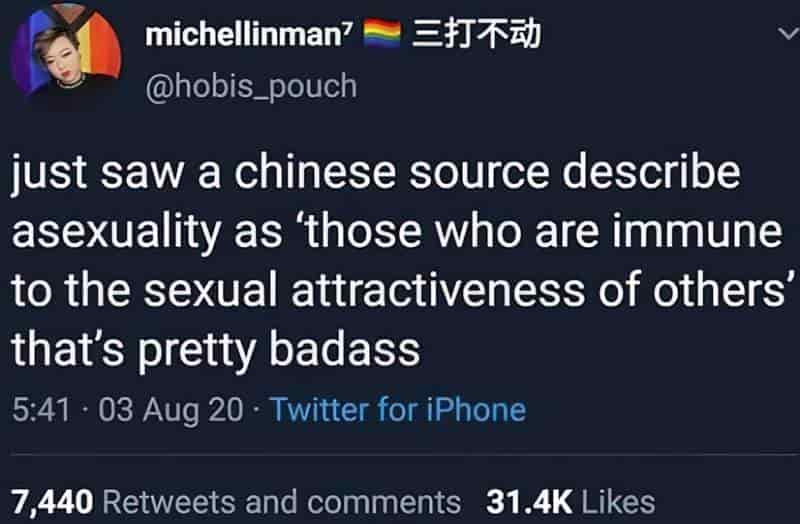
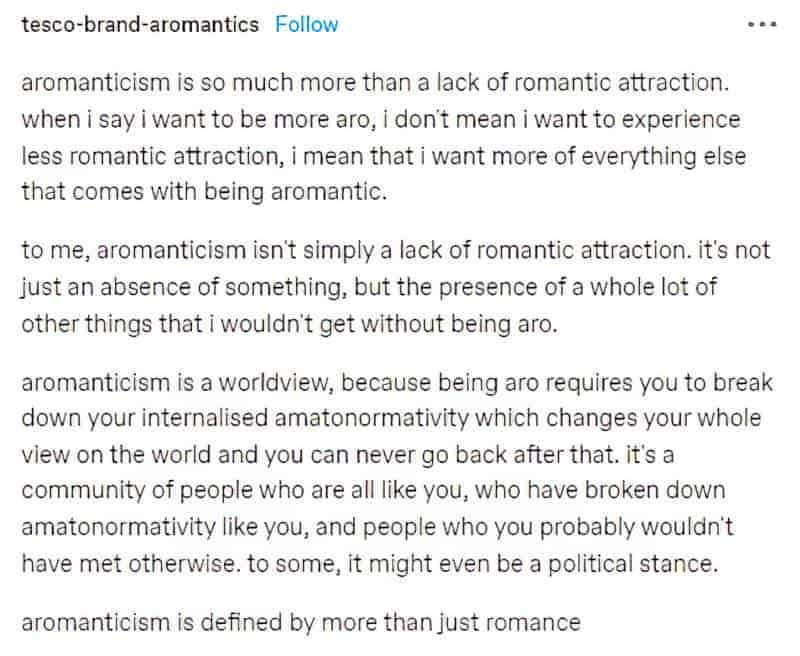


Ace: What Asexuality Reveals About Desire, Society, and the Meaning of Sex by Angela Chen (2020)
Highly readable, part memoir part journalistic. Angela Chen does a magnificent job of steering clear of all the inhouse ace community controversies, and was definitely the person for the job of bring asexuality to a wider audience.
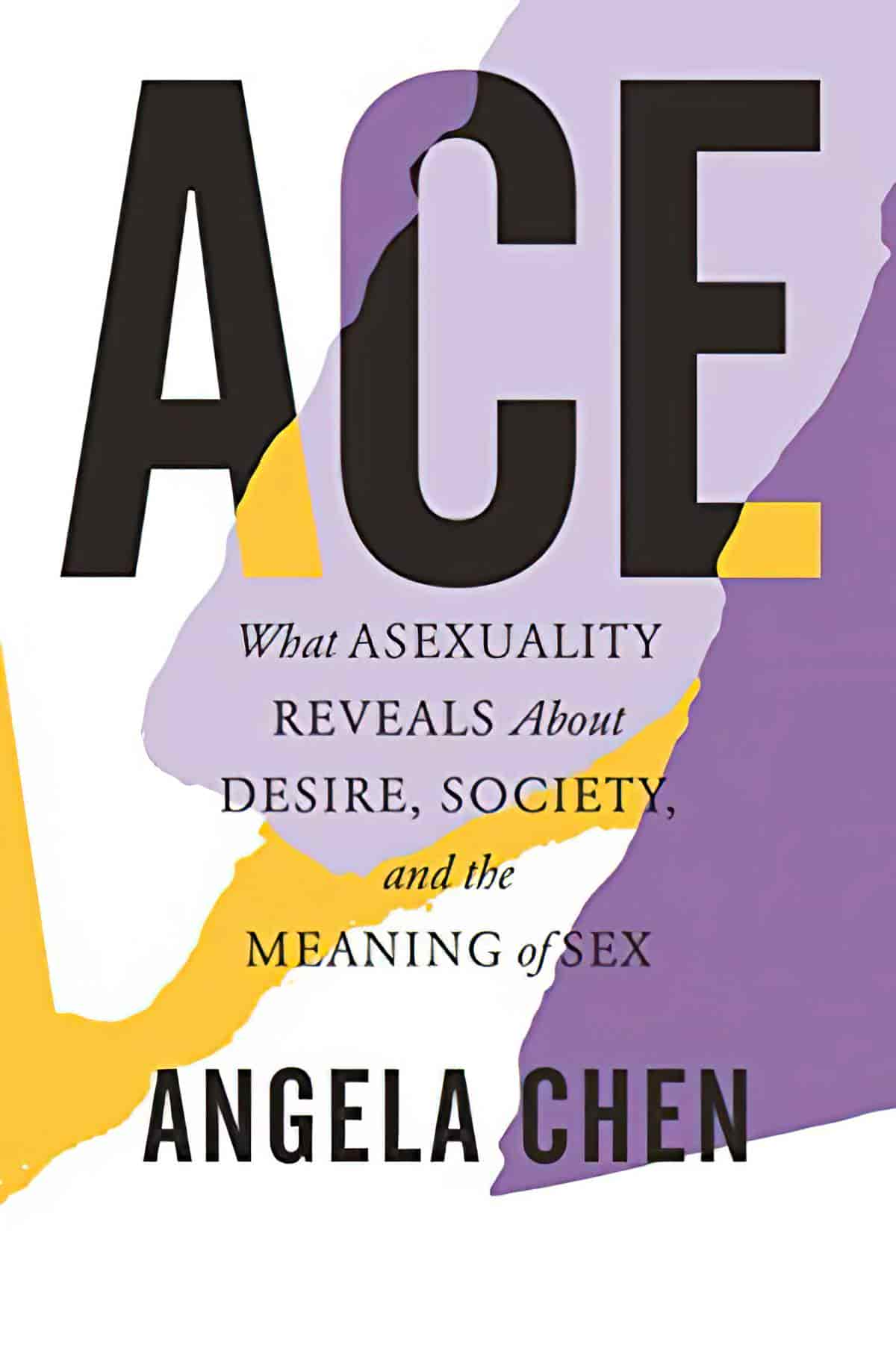
Girls & Sex by Peggy Orenstein (2017)
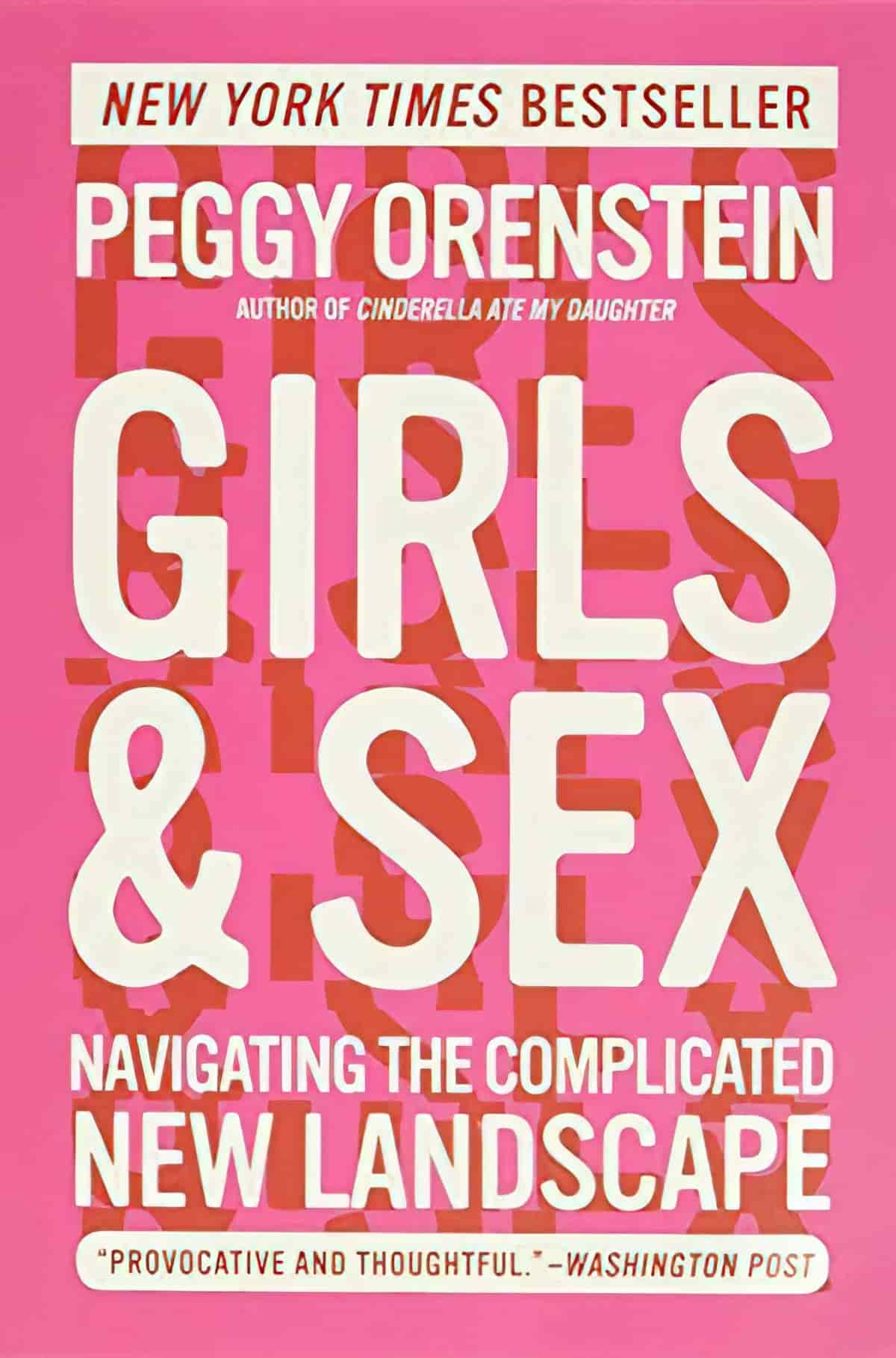
I read The Hite Report a number of years before reading this and was disappointed to see how little things have changed for girls. I’d recommend any of Peggy Orenstein’s work but especially for aces, because this may be an insight into how almost all of your peers are navigating the world.
And since everyone lives in the world of compulsory (cishetero-)sexual normativity, it would be great for us all to understand what’s going on with other people.
Orenstein is American, so of course the culture described skews American.
Boys & Sex by Peggy Orenstein (2020)
The author had no intention of writing about boys as her main interest and expertise as a feminist is girls. However, she was surprised to find people asking her for a book on boys. She was equally surprised to find her male subjects more willing to open up than the girls had been a few years earlier.
And after reading it, it’s even more clear — the best person to be writing about (and understanding the pressures on boys) is a feminist.
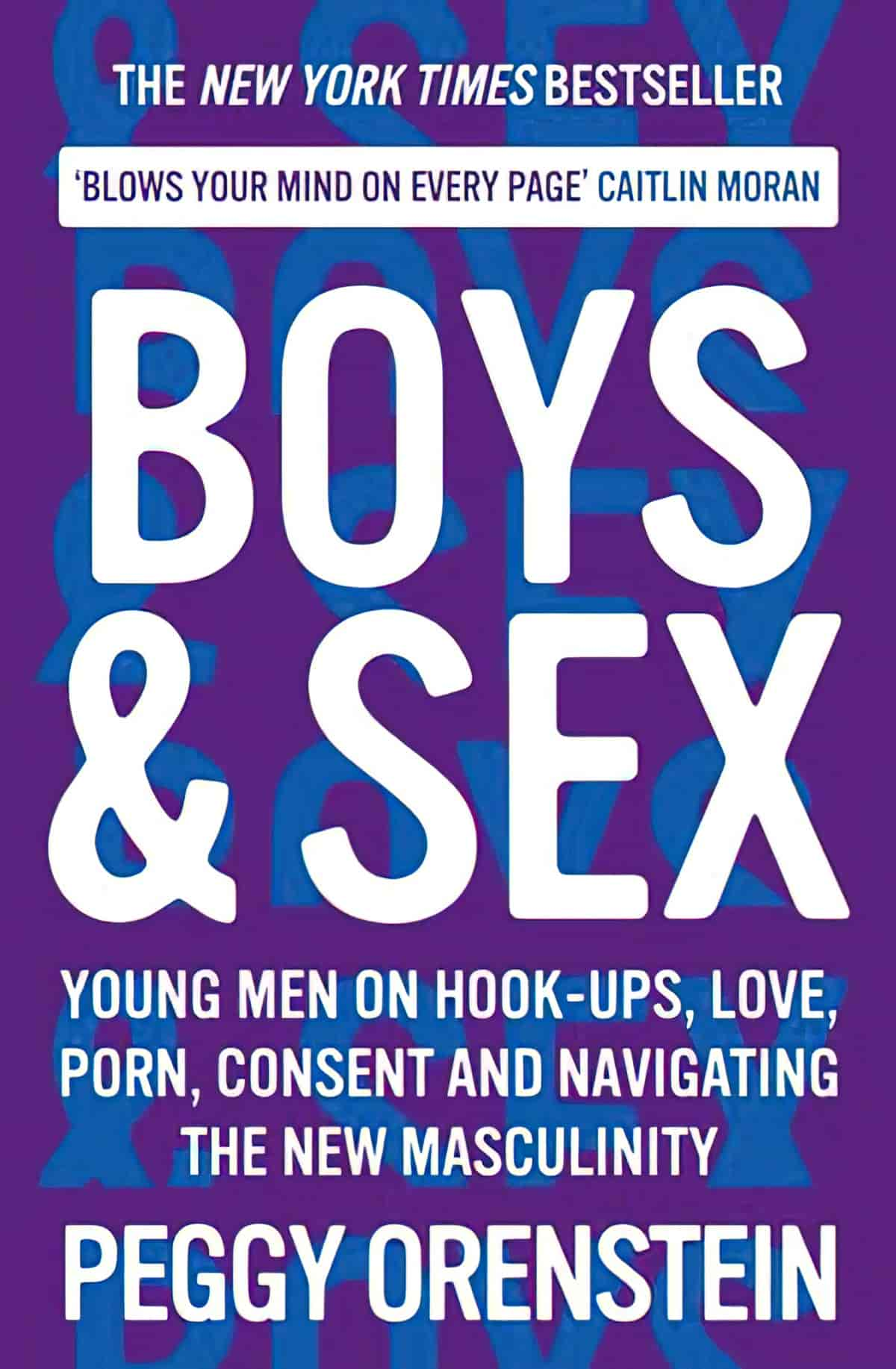
Come As You Are by Emily Nagoski (2021)
This book won’t explain asexuality to aces. No, I recommend it for a completely different reason: It explains the allos.
If you’re an ace who has ever thought that when allos talk about ‘hot’ people, they’re speaking in metaphor, then only later understand this is not actually a metaphor, this book may explain another metaphor which is not actually a metaphor.
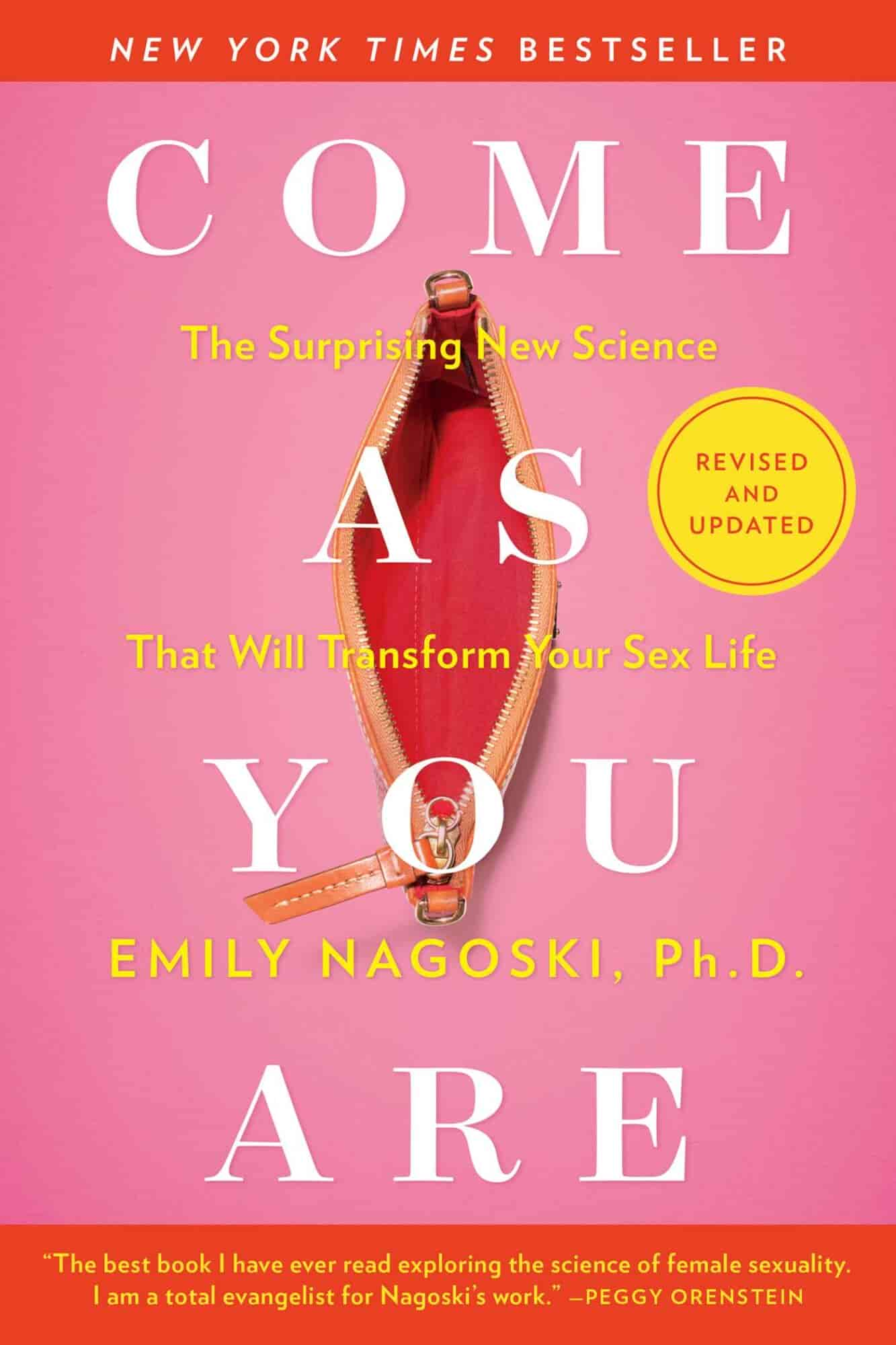
There’s a revised and updated version of this book, so try you get your hands on that one. Originally published in 2015, the revised version came out in 2021.
Emily Nagoski now has a podcast (also called Come As You Are).
I frequently hear Nagoski’s work talked about without credit, which goes to show how some of her big ideas have taken off to the point people don’t remember who came up with them anymore.
The big ideas in here:
- However your sexuality works, that’s okay. You’re fine.
- The difference between spontaneous and responsive desire.
- The dual control model of desire (brakes and accelerator). It’s not just asexuals who believe this is a metaphor. Nagoski’s wider audience must mistakenly think so too, because she goes out of her way to say it’s not in her podcast. The brakes/accelerator thing is not a metaphor, but a real, biological thing that neuroscientists have observed in the brain. (A stimulus can serve as brakes and also as accelerator, depending on circumstance.)
There’s very little about asexuality in this book per se, and I feel there should be more. However, there’s nothing in the book (at least, in the updated version, which is the one I have read) that alienates aces, as Nagoski’s language is sufficiently inclusive. (This is not true of almost all other pop culture books about sex.) Emily Nagoski also uses gender inclusive language.
Where aces may find Nagoski’s big messages alienating: Emily Nagoski talks a lot about how there’s nothing wrong with you for not experiencing continuous and spontaneous desire, especially in long-term relationships. This message is very much pitched at people who do experience sexual attraction (i.e. the vast majority of readers and listeners). So when she says there’s nothing wrong with you for not experiencing desire and libido in an idealised, Hollywood way, this is cold comfort for aces who may be in the throes of navigating something quite different and far more complex from the perspsective of perhaps being in a relationship with an allo/allos. Plenty of aces have high libido and plenty of desire, spontaneous or otherwise. In fact, it can be a real nuisance as well as a joy. It’s the attraction part that’s not there for aces. Especially on her podcast, Emily Nagoski makes the point that so long as you are still attracted to your partner, no problem. She offers many fixes for this. Ergo: If there’s no sexual attraction, there is a problem with your relationship? She has no fixes for this. No advice.
Honestly, Emily Nagoski could (and should) do more to address the difference between attraction and desire. She could be more fully (asexually) inclusive. But asexuality is not in her wheelhouse. (For context, I don’t buy the argument that because asexuals are such a minority that aces are not worth including. A one to five percent of the population is, quite arguably, not a low number anyhow.) The constant emphasis on ‘healthy and normal’ desire has an unintended and unfortunate flipside for the reader who does not experience desire in any form: That absence of sexual desire is unhealthy and abnormal. This would be an error of thinking, a fallacy. But this is a super easy fallacy to fall into when reading about sex as an ace person: i.e. Just because responsive desire is healthy and normal does not mean that absence of sexual desire is unhealthy and abnormal. It doesn’t work backwards like that.
A question for the ages: What responsibility lies with authors in addressing this very common (almost unavoidable, very human) fallacy?
Nagoski is a fill-in-some-blanks expert for aces and allos alike, helping everyone to understand how desire works compared to how it is portrayed in the movies. For aces who experience neither attraction nor desire, Nagoski’s work will serve as an interesting anthropological study into how many/most people experience the world.
An important message from Emily Nagoski which does have particular relevance to the ace community: Move away from desire and focus on pleasure. The focus on desire (wanting to want something) is a patriarchal, capitalist idea. After all, if we were all to start finding pleasure in what we already have (our own bodies, for instance, just as they are) then capitalism wouldn’t be happy with us.
Since wanting to want causes much of the pain associated with being ace, advice to focus on pleasure is super sound. And also, who doesn’t want to put a middle finger up to capitalism?
Refusing Compulsory Sexuality: A Black Asexual Lens on Our Sex-Obsessed Culture by Sherronda J. Brown (2022)
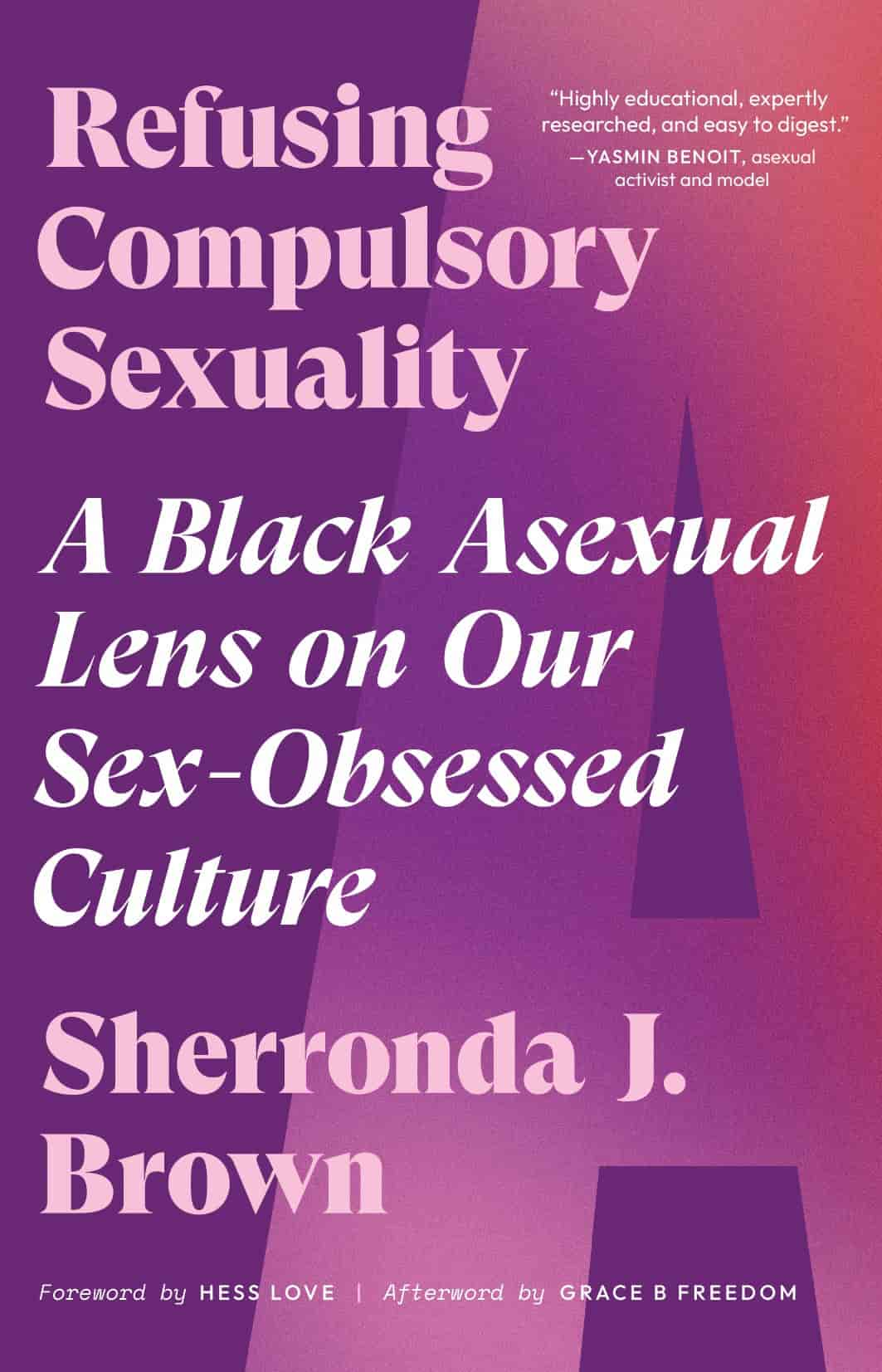
More and more commentary is popping up about compulsory sexuality. Nope, I don’t mean compulsory heterosexuality. People have been talking about that for a while now. I do mean compulsory sexuality: The idea that everyone has to have sex otherwise you are unhealthy, unwanted and/or broken. Compulsory sexuality looks like virgin shaming, the pressure from friends to hook up, pressure from relatives to settle (down), pressure from the advertising industry to look/smell/feel a certain way to attract a sexual partner, pressure from certain sects of feminism to be ’empowered’, pressure from certain famous sex podcasters to be ‘good, game and giving’.
However, the people talking about compulsory sexuality aren’t always the people you want talking about it. For instance, some of them are anti-trans.
The Argument podcast (by the New York Times) aired an episode entitled “What Is Feminist Sex?” aired a (very good) podcast talking about compulsory sexuality in 2022 and recommended the following books:
Podcast host and interview subject mentioned the following:
- “The Case Against the Sexual Revolution,” by Louise Perry (approach with caution)
- “I Still Believe in the Power of Sexual Freedom,” by Nona Willis Aronowitz in The New York Times
- “When Sexual Liberation Is Oppressive,” by Michelle Goldberg in The New York Times
Unfortunately, they did not mention a groundbreaking book which came out just before the podcast aired, by a whipsmart Black, non-binary, asexual author. Without asexual voices in this commentary, any commentary is incomplete.
For readers of Ace and Belly of the Beast: A Black queer feminist exploration of asexuality–and an incisive interrogation of the sex-obsessed culture that invisibilizes and ignores asexual and A-spec identity. Everything you know about sex and asexuality is (probably) wrong. The notion that everyone wants sex–and that we all have to have it–is false. It’s intertwined with our ideas about capitalism, race, gender, and queerness. And it impacts the most marginalized among us. For asexual folks, it means that ace and A-spec identity is often defined by a queerness that’s not queer enough, seen through a lens of perceived lack: lack of pleasure, connection, joy, maturity, and even humanity.
In this exploration of what it means to be Black and asexual in America today, Sherronda J. Brown offers new perspectives on asexuality. She takes an incisive look at how anti-Blackness, white supremacy, patriarchy, heteronormativity, and capitalism enact harm against asexual people, contextualizing acephobia within a racial framework in the first book of its kind. Brown advocates for the “A” in LGBTQIA+, affirming that to be asexual is to be queer–despite the gatekeeping and denial that often says otherwise. With chapters on desire, f*ckability, utility, refusal, and possibilities, Refusing Compulsory Sexuality discusses topics of deep relevance to ace and a-spec communities. It centers the Black asexual experience–and demands visibility in a world that pathologizes and denies asexuality, denigrates queerness, and specifically sexualizes Black people.
A necessary and unapologetic reclamation, Refusing Compulsory Sexuality is smart, timely, and an essential read for asexuals, aromantics, queer readers, and anyone looking to better understand sexual politics in America.
Sherronda has been very clear: They wrote this book for Black people. Black aces face extra issues with being ace. Black people read as fem are sexualised very early, for instance. Black people are not readily believed, in general, and not readily believed even when talking about their own sexuality. Black people are put into stereotypical categories, for instance the hypersexualised Jezebel and the desexualised Mammy.
Black writers are in the very best position to talk about how sexuality (and gender) has been colonised, because Black people have been thinking about this for much longer.
Alongside Angela Chen and others, Sherronda wrote this book partly because of the paucity of literature about asexuality that goes beyond the 101 intro.
Because this book is so well-written, it’s as accessible as a pop culture book. If you’re ace, you’ll find this eye-opening and cathartic. If you’re brand new to asexuality as a concept, read The Invisible Orientation first and you’ll be ready to read this one.
Sexed Up: How Society Sexualizes Us, and How We Can Fight Back by Julia Serano (2022)
Another wonderful thinker in the topic of sexuality, trans gender and now, compulsory sexuality, is trans woman Julia Serano. Sexed Up was written and published around the same time as Sherronda Brown’s book above.
What I especially appreciate about Serano’s messaging in and around the promotion of this book: She does such a wonderful job of explaining how bigotry works and finds the model of stigmatisation especially useful and encompassing.
And who better to speak to that than trans women, right? Serano writes about contagion and how it links to shame.
(Do you know what is actually contagious, though? Distrust. See evidence in Nature Human Behavior, in which perceiving an institution as corrupt undermines trust in complete strangers (not affiliated with the institution). This, in turn, reduces prosocial behaviour.
If you are asexual, or a member of any other marginalised identity, or even simply living a life your community does not ‘approve of’ (even if it’s just living with your partner before marriage), you’ll find this book therapeutic. (It’s not you; it’s them.)
If you want a taste of Serano’s writing, with excerpts from her book, she has a Medium account.
Now, although Sherronda J. Brown’s book is in no way less encompassing than Serano’s, I consider Refusing Compulsory Sexuality the asexual add-on to sexed up. That’s because Julia Serano doesn’t go quite far enough. I wish, somehow, that Serano could have written Sexed Up in response to Sherronda’s book. (A temporal impossibility.) I wouldn’t be surprised if Serano has read Lisa Orlando’s short, seminal essay mentioned above, because the first paragraph of Orlando’s essay is very much in keeping with much of Serano’s point in Sexed Up, that we are all sexualised (and “derivatized” — a term Serano likes and promotes as replacement for “objectified”) by society whether we want to be or not:
We [categorize] our relationships in terms of sex — either friends or lovers. We [engage] in a “sizing up” process, however subtle or subconscious, with each new person, accepting or rejecting her/him as a possible sexual partner even if we never [intend] to become sexually involved.
Lisa Orlando
Serano has, however, done some reading on asexuality, and in Sexed Up refers to The Invisible Orientation. (The book I consider Asexuality 101.) We should expect ace literacy on the part of a trans activist, since a large proportion of the trans community is ace. (Itself a controversial statement, unfortunately, since historically trans people of all orientations were required to hide any same-gender attraction before being allowed to access gender affirming healthcare.)
Anyhow, on page 14 we get our first mention of asexuality, which serves as reassurance that aces won’t be neglected in this book. Serano is also pretty careful to use ace inclusive language, which is done simply by avoiding statements which suggest ‘we are all sexual beings’. She only slips up once when saying all of us are sexual subjects (meaning, rather than sexual objects) and I suspect some aces would reject the notion of themselves as sexual subjects (or objects).
Serano also points out the fact that bisexuals (like herself) have things in common with asexuals. The list of commonalities is longer than Serano included in this book.
More to the point, I’m left a little surprised that Serano didn’t also seem to notice (or at least mention) the overlaps between being trans and being ace (aside from the reality that many aces are also trans and vice versa). For example:
- Marriage consummation laws remain on some books which consider a sexless marriage fraud. Trans people have also legislatively been deemed fraudulent for dressing as themselves.
- Pressure to disclose in the very early phase of dating, before anyone else would be expected to talk about such personal things, such as exactly how their own attraction works, or what their genitalia looks like.
- Vulnerability to predators who develop obsessions over you and people like you.
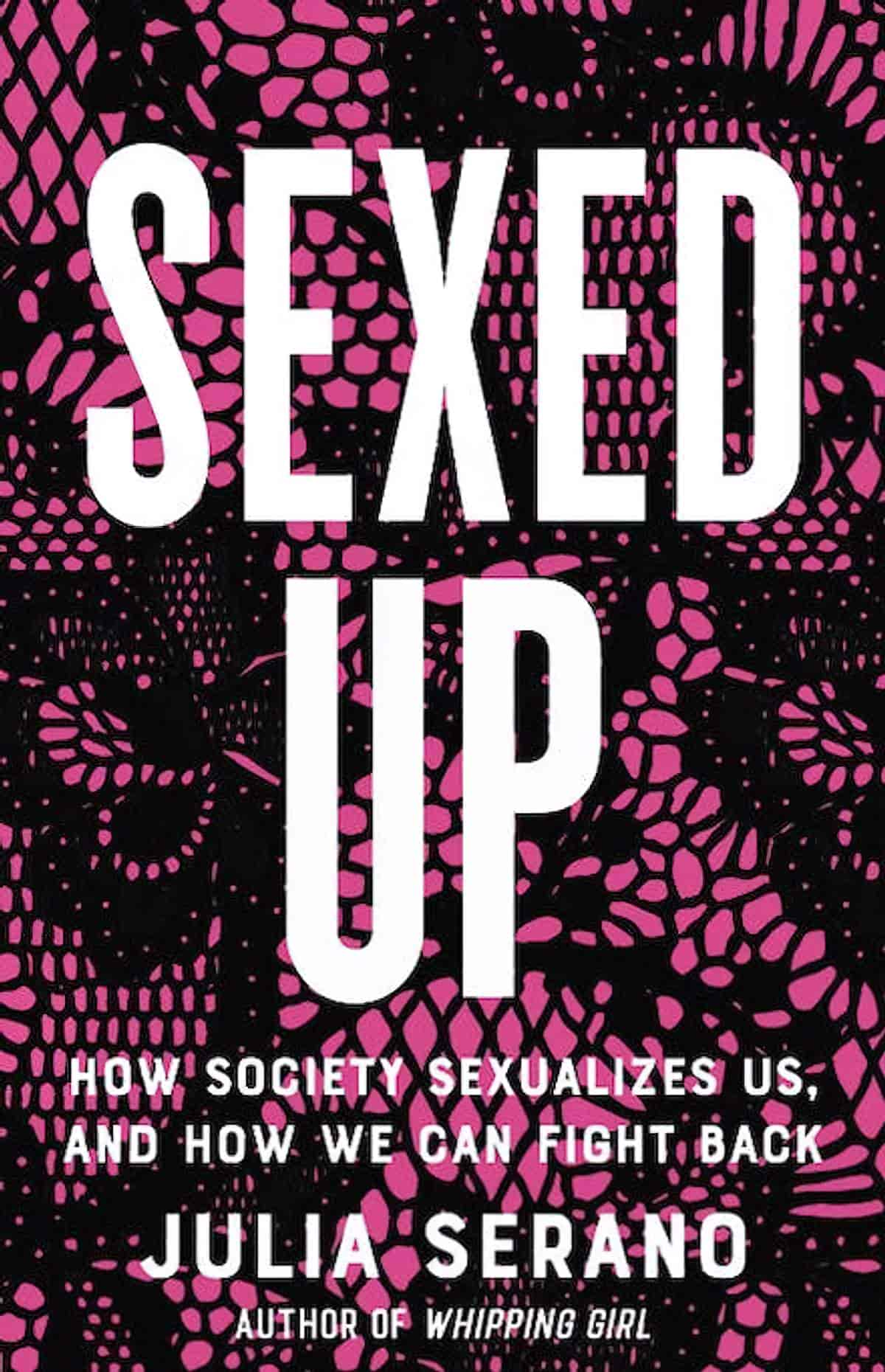
What Love Is And What It Could Be by Carrie Jenkins (2017)
I’m not sure how many people know about this book. I happened across it when a professor I follow on Twitter said she was thinking of making it compulsory reading for one of her courses. (I can’t remember which course.)
Honestly, I think this book could be more meaty. It could probably be an essay rather than a book. But here’s why I recommend it anyway, besides the fact that essays (and books) shouldn’t have to be epic before they are valuable: The author offers a polyamorous perspective. And how often do we hear from polyamorous philosophers? Asexual and polyamorous communities have a number of things in common (aside from the reality that a number of polyamorous people are also asexual).
- Both groups see conceptual overlaps where others do not. For example, as a polyamorous researcher, Jenkins notices a conflation in the terms ‘long-term’ and ‘monogamous’ (p. 93). Perhaps this insight would not have been available to the author had she not been polyamorous. Likewise, aces see a clear distinction between concepts such as desire versus libido versus attraction, where normies mostly do not. The distinction between sex positive and sex favourable is another one from the ace community.
Calling ourselves objective doesn’t make us any less biased (in fact, there is some evidence that it might make us more so). Being “normal” doesn’t mean you have no perspective and no baggage, although it does mean you’re less likely to notice these things. In any case, we can’t make genuine philosophical progress on the hard questions by stuffing our personal baggage behind the sofa of “objectivity” and hoping nobody looks there.
***
One’s privilege can make it harder to get critical insights into the things affected by that privilege, for the simple reason that the workings of privilege are usually far easier to notice and understand when you are not their beneficiary. Beneficiaries of privilege often are not even aware of its existence: they have never needed to be. To compound this problem, it can be deeply uncomfortable to regard one’s own favorable position within a social structure as due to privilege rather than solely one’s own merits and efforts. So the beneficiaries of privilege can be strongly motivated to ignore it. If you are trying to figure out how romantic love works at a time when it is intimately bound up with sexism, heteronormativity, and other systematic oppressions, privilege is a philosophical hindrance.
Carrie Jenkins, What Love Is And What It Could Be (2017)
- Both groups are interested in relationships which fall outside the hegemonic norms of relationships e.g. queerplatonic relationships. Jenkins writes: “If we do start experiencing very powerful feelings of care or desire for a friend, we are pressured to interpret this as falling in romantic love. (p.53)”
- Jenkins also questions the accepted wisdom from researchers so far who keep telling us that romantic love has two main phases: The exciting first stage (what others have called limerance) followed by a long, less exciting but more stable phase. This does not take into account the large number of couples who say after many years that they are still very excited by their partners. Nor does it account for the type of love which happens gradually, for example when long-term friends realise they love each other deeply. (p. 23)
- On page 65 she talks about amatonormativity, which is something both polyamorous and asexual communities notice keenly because it looks a bit different as an outsider.
- Both groups are very well placed to query the concept of ‘nature’ and how the ‘natural’ label is applied after ideology, as a way of maintaining a hierarchy (p. 85). (All queer communities are well-positioned to query this.)
- Both groups are interested in the sex positive movement. Jenkins tracks the beginnings of this movement to the unlikely figure of Bertrand Russell (p. 56) with the disclaimer that the guy was imperfect in many other ways.
- Jenkins does a great job of teaching what ‘social construct’ really means, compared to a common misconception about it (p.49).
So, is love a social construct? The main idea of Jenkins’ book is explained on page 12. She writes of the dual nature of social and biological factors and considers the field of philosophy an excellent way to explain how love comes down to both. (Isn’t everything, ultimately?)
Mostly I would recommend this book on love because there are others (critiqued by Jenkins) which are widely read, and which claim to offer diversity, but which offer only the opinions of male philosophers. Worse than that, they treat women, as a class, as other.
With love and with women, there is cultural potency to the idea that mysteriousness is part of what is special about them.
Carrie Jenkins, What Love Is And What It Could Be (2017)
If you’re ace and you’re wondering if you might also be aromantic, you’ve probably wondered what ‘love’ and ‘romantic’ even mean. The truth is, those concepts and definitions very much depend on time and place. No wonder it’s so confusing.
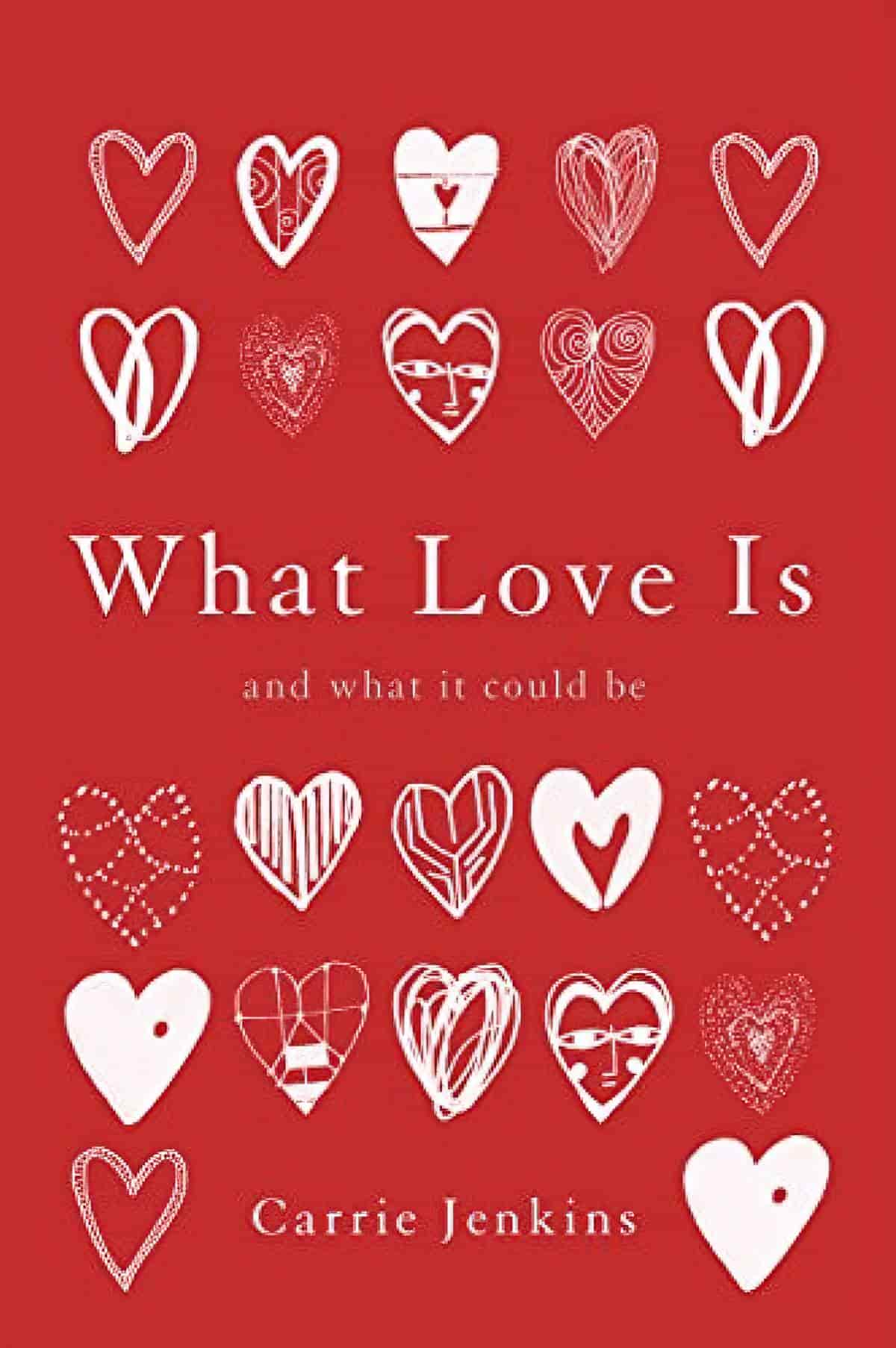
(By the way, it’s completely fine to disidentify with romantic/aromantic labels, or any of the other microlabels — labels are there for you to use and not use as you see fit.)
Entitled by Kate Manne: How Male Privilege Hurts Women (2021)
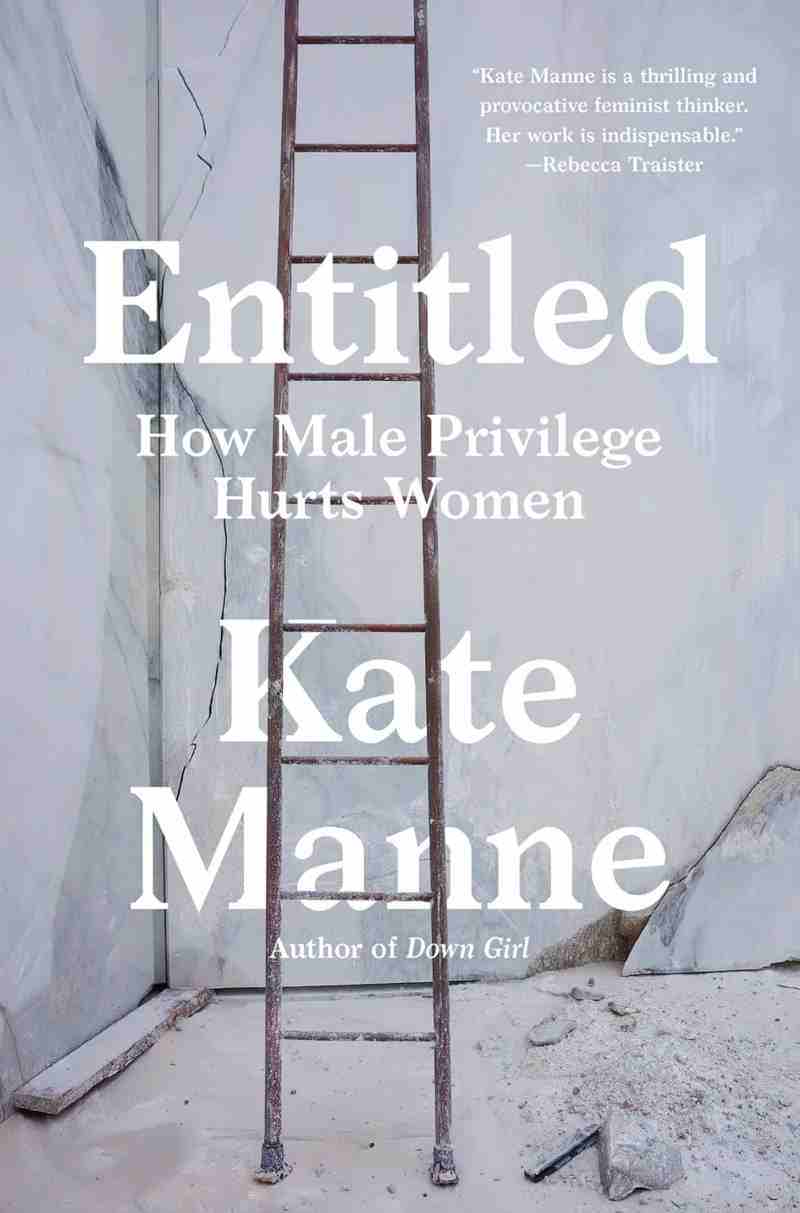
Speaking of feminist philosophers, this book is a must read. If you are fem, you may find this book confronting because you’ll be left with a clear-eyed view about how you have been expected to perform sexually, or just exist for the (male) sexual gaze.
Though different in content, this book is a more readable version of Kate Manne’s first book, Down Girl, which is a much easier read if you’re trained in philosophy. (I’m not, so I did a lot of annotation and looking-up of things.) Entitled is an easy read compared to that, but only in the sense of ‘understanding’. It’s also a grim look-back into some difficult events which made world news.
This should be a given by now, but I appreciate that Kate Manne uses not only gender inclusive language, but when talking about queerness, also includes examples of asexuality when listing examples of queerness. (This should be a given but is far too rare.)
Gender Outlaw by Kate Bornstein: On Men, Women, and the Rest of Us (2016)
2015 was when things started to change regarding genderqueerness. This was perhaps marked by Caitlin Jenner coming out. Suddenly (for better or for worse), trans people — especially trans women — had more visibility.
So no wonder we got a revised edition of this 1994 book the following year (2016). Then the pandemic happened and all that time alone to reflect was the reason for a lot of people understanding their own relationship to gender.
The fact is, asexual people have a different experience of gender. No one fully understands gender (or attraction, for that matter) so no one can tell you why this is, but it’s actually a more interesting question to ask: How does orientation cement the gender of the allocishets*?
*allocishet = allosexual (not asexual), cisgender, heterosexual.
This book is not about asexuality, it’s about being trans non-binary. Kate Bornstein came of age in an era where if she/they didn’t feel like they were a man, they must be a woman. She only knew she wasn’t a man. It is this feeling of ‘not’ which aces have in common with non-binary people, and one day perhaps science and sociology will be able to tell us why such a huge proportion of aces are also non-binary. For now we must sit with the half-formed idea that, for the allos, orientation seems to have a big part to play in their own conception of gender.
Kate is clearly an outgoing character. This book contains transcripts of interviews they have done over the years. Her description of being trans non-binary will feel familiar to aces. For example, being asked about your genitalia. Perhaps borrow Kate’s response to, “Does it work?”:
“Yuh, the plumbing work and so does the electricity.”
(Eternal caveat, avoiding ableism and compulsory sexuality: Even if neither ‘plumbing’ nor ‘electricity’ ‘works’, you’re still ace if you feel the label fits.)
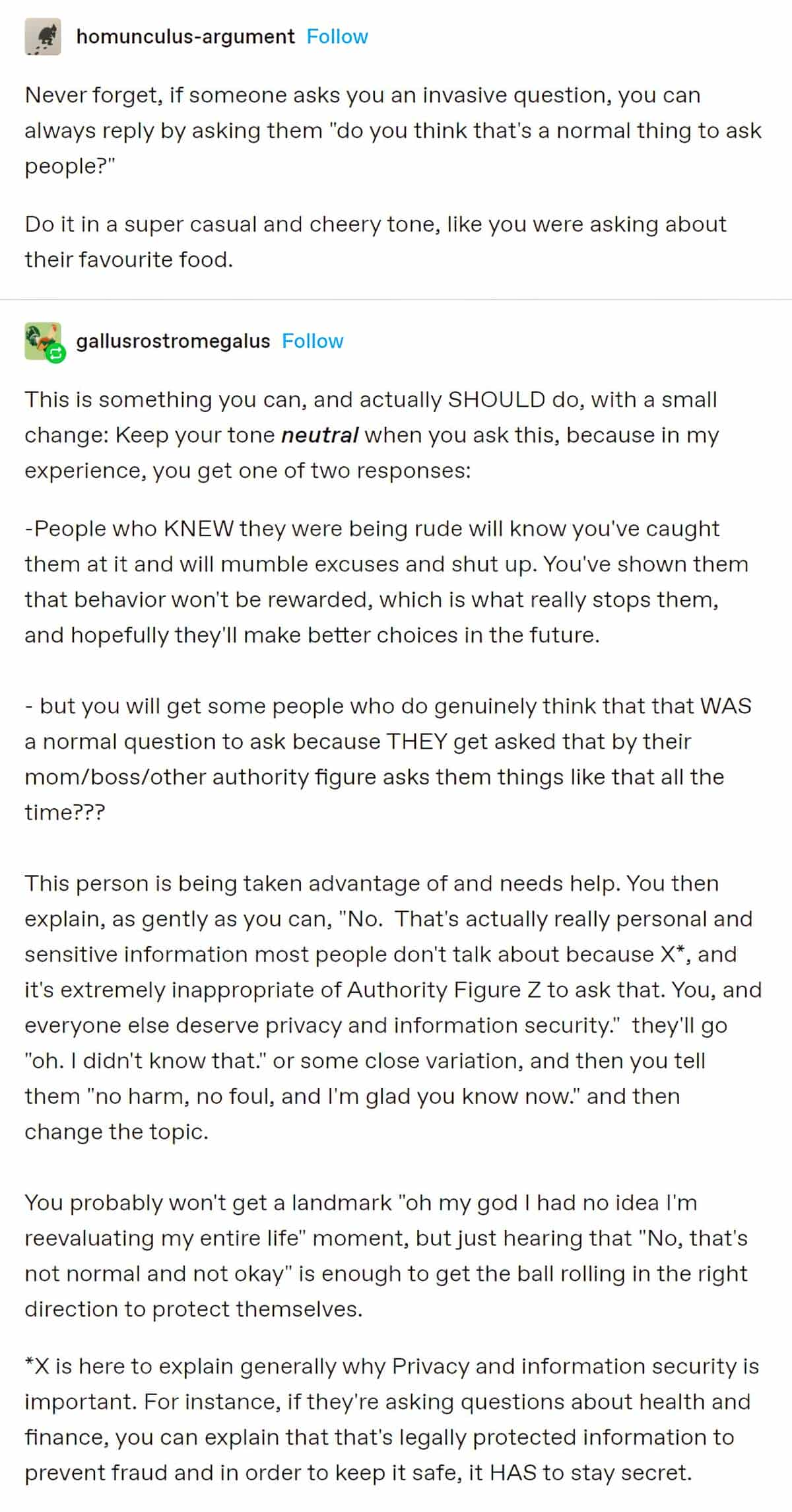
In general, this book will highlight further correlations between being ace and being trans. For instance:
We live in a culture that succeeds in selling products (the apex of accomplishment in capitalism) by aligning those products with the attainment of one’s sexual fantasies and gender identity. Switching my gender knocked me for a time curiously out of the loop of ads designed for men or women, heteros or homos. I got to look at both biological sex and sexuality without the hype, and ads without the allure. None of them, after all, spoke to me, although all of them beckoned.
Gender Outlaw
Sherronda J. Brown has a whole chapter on this from a Black ace perspective, but it’s interesting to read a book by a non-binary trans femme and realise how similar the experiences can be.
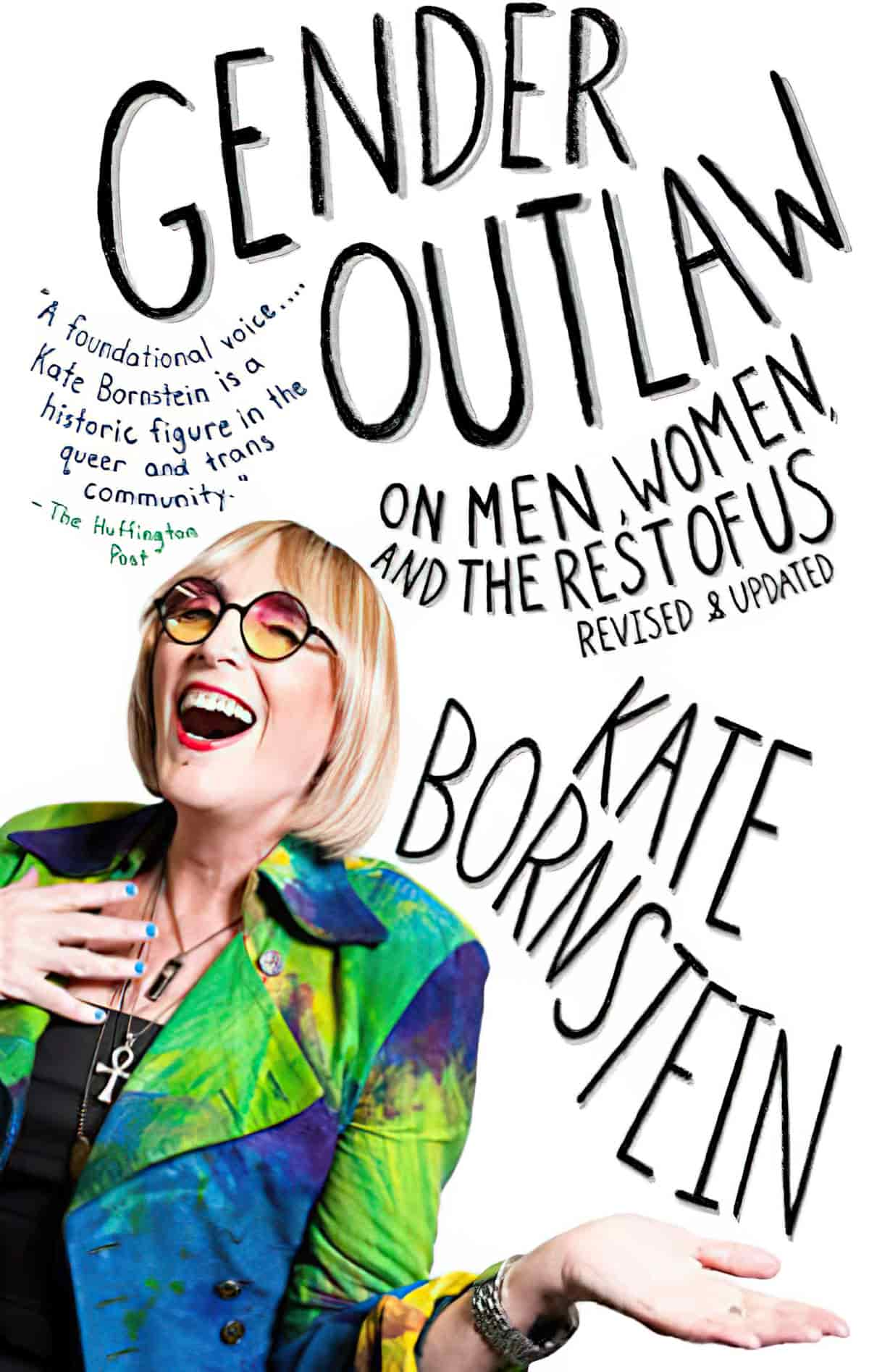
Like Julia Serano, Kate Bornstein misses opportunities to draw parallels between asexuality and trans gender, even though this edition was revised in 2016, when people with a long-term interest in queer identities really should have been paying asexuality more attention. There are definitely times in this book when asexuality feels erased. (It’s not called The Invisible Orientation for nothing.)
But if you can overlook this, there are plenty of thought-provoking points which aces will find thought-provoking. Namely, Kate Bornstein comes down on the side of ‘we’d all be better off without gender’. So many aces are also agender or non-binary. Why is this? No one has worked that out, yet, but take this quote:
When we play with our identities, we play with [sexual] desire. Some identities stimulate desire, others diminish desire. To make ourselves attractive to someone, we modify our identity–and this includes gender identity.
Kate Bornstein, Gender Outlaw
This is part of a wider discussion (“Naming All the Parts”) about how bizarre it is that in our society identity is based on someone’s attraction to gender, when it could easily be based on something different entirely. (Bornstein thanks trans people for shaking up the gender binary, but could just as easily thank aces for shaking up what it means to be attracted to something other than genitalia.)
I like how Kate Bornstein quotes Wendy Chopkis, defining the difference between femme and butch, which isn’t about gender at all, but is instead about (the more dynamic and inclusive) gender roles — a distinction we could all use:
Butch style, whether worn by men or women, is a symbol of detachment. dressing butch gives the wearer the protection of being the observer, not the object. A femme-y look, by contrast, suggests self-display, whether in a quietly demure or sexually flashy fashion, Butch is a style of understatement: “I don’t need to show flesh because I am in a position to choose.” Butch is no coy “come hither” look, but a challenge–“I see you and maybe I like what I see.”
There is something about femme-y style that in itself produces insecurity, a sense of vulnerability and exposure. The femme invites the gaze and it takes a great deal of feminine self-confidence to risk that kind of scrutiny.
Wendy Chapkis, Beauty Secrets: Women and the Politics of Appearance, 1986
Assuming a large number of aces (but never all) would prefer to avoid the vulnerability, exposure (and sexualization) packaged with femme gender roles, it makes sense to extrapolate that an ace who feels neither femme nor butch nor sexual attraction would feel most comfortable, most themselves, with the role of non-binary or agender.
Kate Bornstein is also very familiar with how she panics audiences by suggesting we eliminate gender as a concept. Aces can get the same reaction simply by coming out.
Our culture is obsessed with desire: it drives our economy. We come right out and say we’re going to stimulate desire for goods and services, and so we’re bombarded daily with ads and commercial announcements geared to make us desire things. No wonder the emphasis on desire spills over into the rest of our lives. No wonder I get panicked reactions from audiences when I suggest we eliminate gender as a system; gender defines our desire, and we don’t know what we have if we don’t have a gendered desire. Perhaps the more importance a culture places on desire, the more conflated become the concepts of sex, sexuality, and gender.
Kate Bornstein, Gender Outlaw
This is one of the few paragraphs I’ve ever read which positions the people with gender as the marked demographic. Normally, almost everywhere else, it is those few who dispense with gender considered marked, abnormal, unusual. What if we consider absence of gender the unmarked state-of-being, and instead start delving deeper into why the allosexuals are (mostly) so wedded to their gender identity?
The Politics Of Trauma by Staci Haines (2019)
Ace people are regularly accused of or at least questioned about whether it’s ‘real asexuality’ or ‘just trauma’. The fact is, living as an asexual person in a culture of compulsory sexuality means it’s very difficult to avoid trauma, especially if you don’t understand your own asexuality while still very young. (Similarly, it’s almost impossible to live in the world as autistic without trauma, because of the way society is set up for neurotypicals.)
That’s why this book is of particular interest to asexuals, but like every other book on this list, is really for everyone.
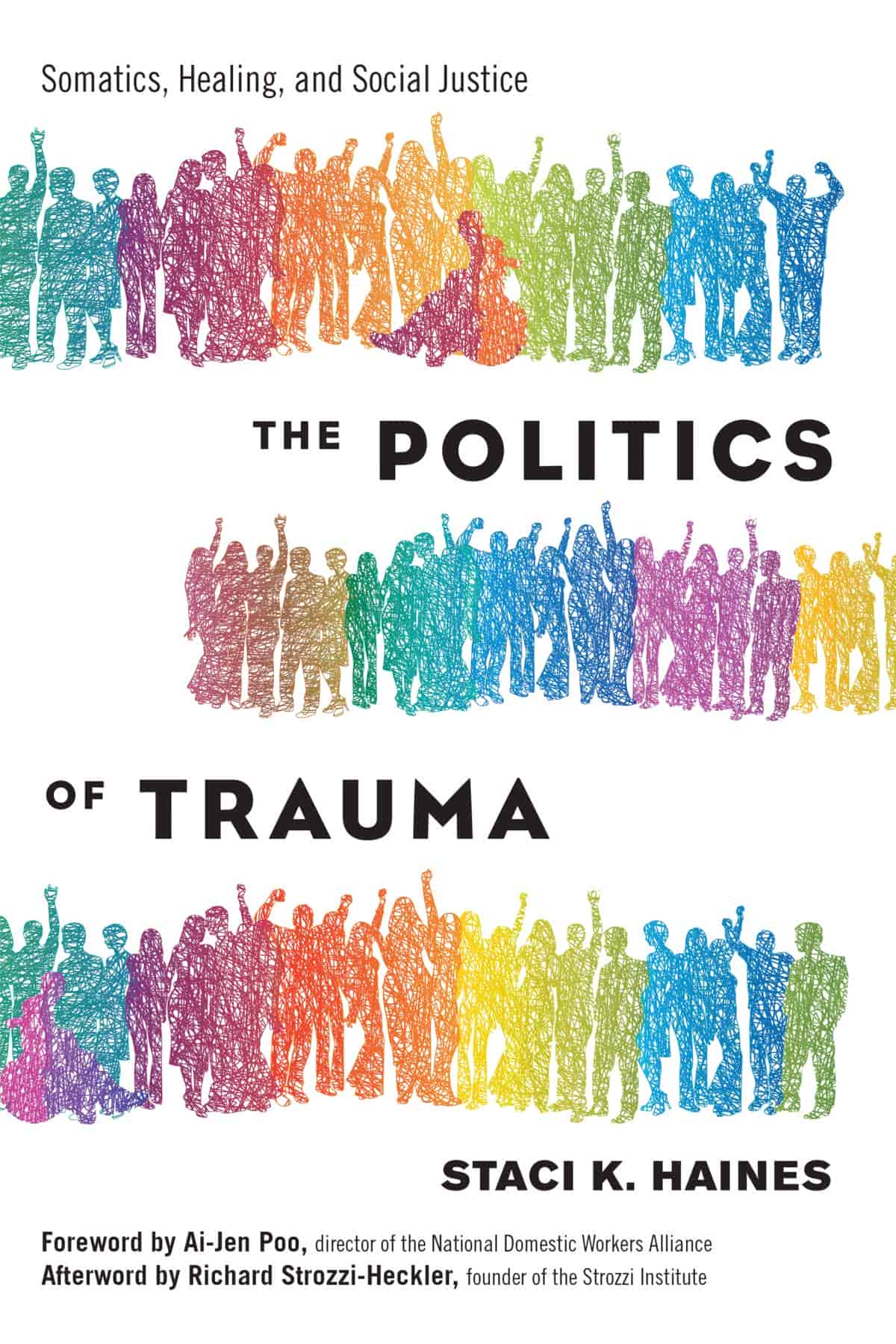
Pleasure Activism: The Politics Of Feeling Good by Adrienne Maree Brown (2019)
No more self-denial. Politics should be a resounding, erotic “yes,” not another deadening “no.”
Hear the author interviewed in Episode 54 of the Sensual Self podcast.
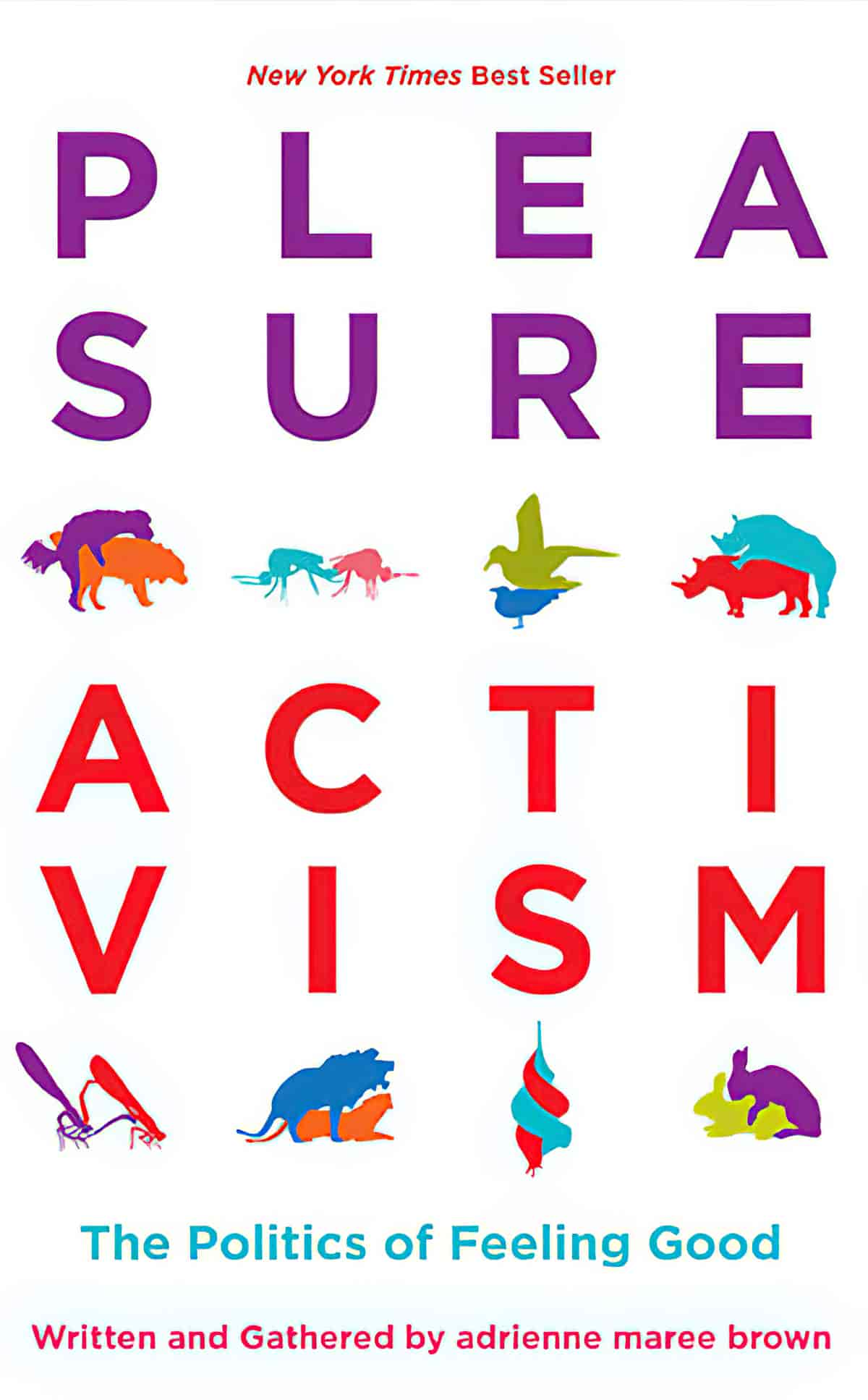
Uses of the Erotic: The Erotic As Power by Audre Lorde
On the topic of pleasure, the definitive guide on the meaning of erotic comes from Audre Lorde who wrote a famous essay. Hear the author read it on YouTube. You can also find the essay itself online very easily.
By Lorde’s definition, the erotic is not necessarily sexual. A synonym might be ‘aliveness’. Anything that makes you feel good is the erotic, standing in direct opposition to powers who value people only for our productivity.
David Baddiel’s Jews Don’t Count TV documentary
On the surface, this documentary about Jews and Judaism has nothing to do with asexuality. But once David Baddiel claims that Jews are the only marginalised group left which the left continues to marginalise, aces will know that this is not exactly true.
Jews and aspec people share this in common: Even “allies” who purport to be on the left continue to marginalise both Jewish people and aroace people.
A shoutout to people who are both Jewish and aspec.
The Sensual Self Podcast
Speaking of the Sensual Self Podcast, the host Ev’Yan Whitney fairly recently realised they were gender non-binary and ace, and is just one excellent example of how the sex education community (and also the kink community) is heavily populated with asexual participants.
I wouldn’t recommend all of the episodes of this podcast, which can run to the woo-woo at times, with guests into astrology and so on.
The Ace Couple Podcast
Yes, many aces are married. Some to each other, e.g. Courtney and Royce. Courtney did an especially good job of describing the intersection of asexuality and disability in an episode called “The Complicated Intersections of Disability and Asexuality“.
The episode called “Asexuality and Kink” is also thought-provoking, especially if you have trouble with the reality that the kink community is populated with many aces, and there’s absolutely nothing strange or mind-bending about that. In fact, it’s the natural consequence of aces needing to search beyond the obvious for sensual pleasure.
The A OK Podcast
This podcast ran for about a year between 2019 and 2020. Every single one of the episodes is great, and is in interview format with a wide variety of ace people. Listen to them all and you’ll get a sense of how broad the community is. There really is no such thing as The Archetypal Ace.
Ace Dad Advice
Ace Dad is an educator by profession and this comes through in his YouTube videos. One of his main messages: Never apologise for being ace. You don’t have to apologise for it or feel there’s something wrong with you, which is something aces need to hear.
Cody Daigle-Orians also has a book coming out (2023) called I Am Ace: Advice on Living Your Best Asexual Life. It will be aimed at teenagers:
How do I know if I’m actually sexual?
marketing copy
How do I come out as asexual?
What kinds of relationship can I have as an ace person?
If you are looking for answers to these questions, Cody is here to help. Within these pages lie all the advice you need as a questioning ace teen.
Tackling everything from what asexuality is, the asexual spectrum and tips on coming out, to intimacy, relationships, acephobia and finding joy, this guide will help you better understand your asexual identity alongside deeply relatable anecdotes drawn from Cody’s personal experience.
Whether you are ace, demi, gray-ace or not sure yet, this book will give you the courage and confidence to embrace your authentic self and live your best ace life.
Queerly Podcast
This Australian podcast goes into queer history, is very well researched and the hosts are a fun listen. Importantly, they include asexual history (not a given, unfortunately):
- Asexuals Have Problems Too — insight into an old satirical piece in The Village Voice which was meant as satire, but taken straight by people who were in dire need of something about asexuality even if it was satire.
- The Asexual Manifesto — a well-researched piece into asexual history, using sources who really know what they’re talking about
- Marsha P Johnson — who may have been asexual
- Horace Walpole — another historical ace icon
See also: Never Invisible: Asexuality in History and Boston Marriages: Lesbian, Queerplatonic, or something else? by Andrea Mariana
Sex and Psychology Podcast
Be careful with this podcast. I wish it were better regarding asexuality because the host knows so many things, but Dr Justin Lehmiller has interviewed a number of people to avoid (including James Cantor, see below) and has had at least one terrible sponsor (who sells a product to increase sex drive, with irresponsible use of the word ‘asexual’ as part of his creepy, conversion-therapy-esque marketing campaign).
Dr Lehmiller is a Kinsey Institute Research Fellow. Famously, Alfred Kinsey left asexuality off the linear spectrum of possible orientations — right off to the side there, marked with an X. In that tradition, of the many topics Justin covers in his podcast, asexuality remains a siloed topic.
However, I do highly recommend episode 65, “Understanding Asexuality” because he interviews Dr Morag Yule. And Dr Yule absolutely knows what she’s talking about, having conducted research with Dr Lori Brotto.
A few months later, in an episode called “The Laws of Attraction”, there was plenty of opportunity to mention asexuality at least once, since the asexual community is absolutely expert on this topic, and understands keenly the difference between attraction and desire.
But no, asexuality was back to the silo, already covered in The Asexuality Episode. Here’s hoping he comes back to it when he finally realises how much the asexual community has in common with the allos, with extra insights which really only come from being asexual.
The Graying Rainbows Podcast
This is a podcast hosted by Ginger Campbell, featuring interviews with people who came out as queer late in life.
I was about to recommend this podcast to older aces, but actually, precisely because the interview subjects are mature and have lived during an era of non-acceptance, their insight is especially valuable to people of all ages.
The vast majority of interview subjects are LGBT, but there is one interview with Sondra Julie Decker (author of The Invisible Orientation). This podcast seems to be on hiatus since the end of 2021, which makes Decker’s interview one of the latest. (2 July 2021.)
Why school up on asexuality?
Content note: Specific examples of extreme ace phobia below.
Now you’ve made it to the end of this post, you know more about asexuality than almost everyone, even without reading the recommended books.
Ace phobia is everywhere. It is rife. This Wikipedia article covers a lot of it, but it goes much further than that.
Check out this letter, answered beautifully by Captain Awkward, and notice how asexuality is (probably) being appropriated and definitely being used as an excuse for very bad behaviour within a heterosexual marriage.
Revision exercise
It’s highly likely that reading material listed above will get you to a better place than many — if not most — psychologists and sex therapists ever could. This applies even when the psychologist is themselves queer (but not ace) and even when they specialise in sexualities. Here’s a classic example. As you read, highlight the problems with it. Warning: You’ll run out of chartreuse ink, as this short conversation captures a comprehensive range of acephobic talking points:
Interviewer: What about asexuality, the least sexual of the sexual paraphilias?
James Cantor: Yep. Ah, There’s no good simple answer. I don’t think it’s an ‘it’. The term is a bit of a catchall. People these days especially are kind of mixing up medical language, you know, a medical diagnosis where we’ve identified the cause of something with psychiatric diagnosis which doesn’t identify the cause. Psychiatry’s different from other branches of medicine. In psychiatry they label the symptoms. We just call the symptom depression or sadness ‘depression’. But whether it’s caused by one thing or another, that doesn’t matter. You get the same diagnosis. So psychiatry is unlike the rest of medicine in that it labels just the symptoms. So for the paraphilias and the others that’s, as I say, kind of an open question as to exactly where the line goes. When do we diagnose it? When do we not? Is it in the person’s favour? So, as I say, it’s not such a simple question. So for asexuals, well, it’s not posing a problem for anyone else. And there can be way more than one thing leading a person to thinking that label kinda fits them. Now, it could be somebody just with a low sex drive. But ‘low sex drive’ isn’t a– pardon the pun — very ‘sexy’ label for it. But ‘asexual’ is a label they can use. “All of a sudden I have a support group…”
Interviewer: [interrupting, indecipherable, something about a ‘wave’]
James Cantor: Ah, the part it’s very easy to be empathetic for is, socially it tells people how to interact with them. Don’t start introducing them to potential partners, you know, they’re not gonna be interested. And don’t take it personally. So it serves a kind of a legitimate social function. Flipside: They are just regular everyday people with regular, everyday insecurities, you know, whatever it is about their sexual life. And rather than risk rejection, rather than play at that game and risk losing, they adopt the label ‘asexual’ just to get out of the whole thing. You know, that’s not such a healthy reason. You know, if I had such a person in therapy it’d be reasonable to help a person get over their insecurities.
Or for some people, especially on the autism spectrum, there are people who have social skill deficits. It’s really social skills training that would lead to more self-confidence so they don’t need a label of asexual.
And, you know, as people get older and sex drive drops, again, will adopt the term as a euphemism for low sex drive. Ah, so although they kind of have in common a signalling to the people around them, how to interact properly, or how to interact in a way they want to be interacted with, we oughtn’t, or scientists should take it at face value to mean literally that the person lacks a sex drive either. A lot of people can adopt a label for a lot of other kinds of reasons.
All of which is to say, it’s not like we have proof that it doesn’t exist either. I mean, if you could be attracted to one pattern, attracted to another pattern, I can imagine attracted to neither? But the last one, because of the very strange seat that I get to sit in, that somebody’s attracted to something unusual that they don’t want to cop to. You know, it could be something really, really problematic like they’re attracted to children, or they’re just attracted to something like, right, in the particular audience [sic] or in front of their family or for whatever reasons they don’t want to be out with it. It’s not something they’re going to be sharing with anybody outside, for example, outside of their fetish community. So again they will adopt the label asexual to cover for the real story or people don’t want to admit to themselves what it is that they’re into. So again they give themselves a reason to not be into anything.
Interviewer: You blew my mind when talking about why there seem to be more child offences coming out of the Catholic church. Priests, the priesthood, a place where you take a vow of celibacy, you are tending to be away from most of the people. This is a life a life of service, this is a life of virtue, that would be the kind of place that someone who is kind of potentially, in some circumstances, hide from a sexuality that they’re a little bit concerned about, might retreat to. I thought, oh wow, that is such an interesting way to look at why there has been this preponderance in there, and it plays into that as well. I’m pretty sure that a bunch of very famous inventors throughout history, Isaac Newton, I’m pretty sure he went through his entire life and remained a virgin. There may have been some sort of religious overtones over that. But how much he was using the religiosity as a cope, that justified something that was coming out of him that he perhaps didn’t want to face. But year, two really interesting parallels that I’ve seen there. Figures from history, high performing philosophers, some of them engineers, physicists that didn’t want to face anything sexual. Is that a by-product, is that a cope, are they hiding something? And then the priesthood as well. Two really interesting examples.
James Cantor: Yeah. Ah, the priesthood’s a funny one. There’s no good way to study it in any objective way. There’s just so much politics pulling in every direction. But some people use it as a retreat. So, you know, “my family stops asking me how come I’m not married to a woman.” But not only for pedophiles, but also regular everyday gay men who don’t want to deal with being gay. Less of a problem today than generations [ago] but same thing. It was an escape into, in that context, a socially acceptable or socially more acceptable way to still circulate in society, being productive in its way. But ah, it’s living a hidden life, I don’t want to say ‘in plain sight’ exactly, and for some people they’re denying the truth of it to themselves as much as denying it to the world around them.
Dr James Cantor, “The World Of Unusual Sexual Orientations” at the Modern Wisdom podcast, which also talks a lot about Jordan Peterson, so there you go. (from the 6:53 mark)
Related concept: Relevance Deprivation Syndrome e.g. When you feel you’re not getting enough attention e.g. You’ve been banned from various academic listservs for your outrageous ideas so you find a new platform with the far right media instead.
If you are nodding along thinking these two make some pretty good points, actually, definitely read the books. This conversation is an example in real time of a gay man with a doctorate and a platform persuading another man that the problem in the Catholic Church is asexuals, actually, deflecting away from ‘the gays’ (who copped it big time until the very recent era of asexuality visibility).
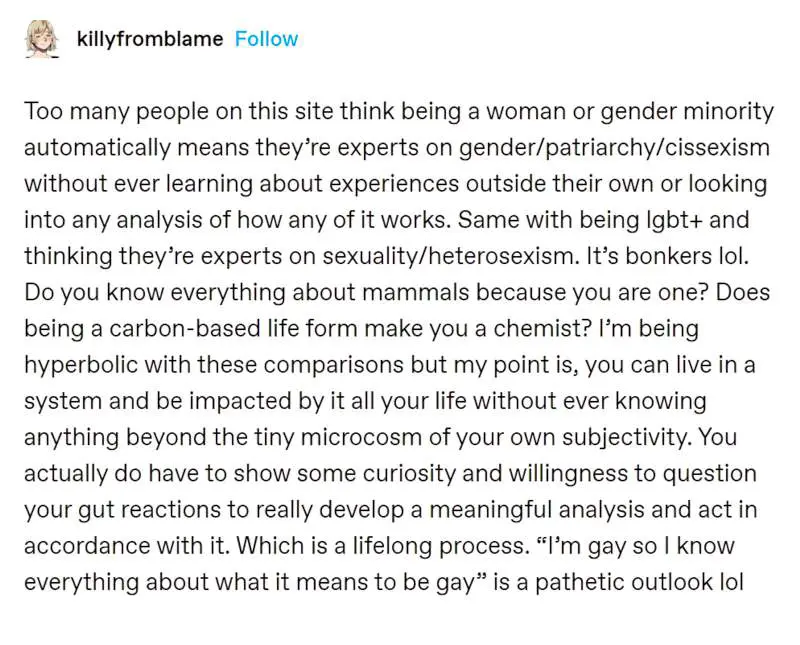
The terrible irony is that asexuals are the most likely demographic to be pointing out the problematic culture which conflates attraction with sexual interest in the first place, a form of gaslighting which groomers absolutely use to their own end:
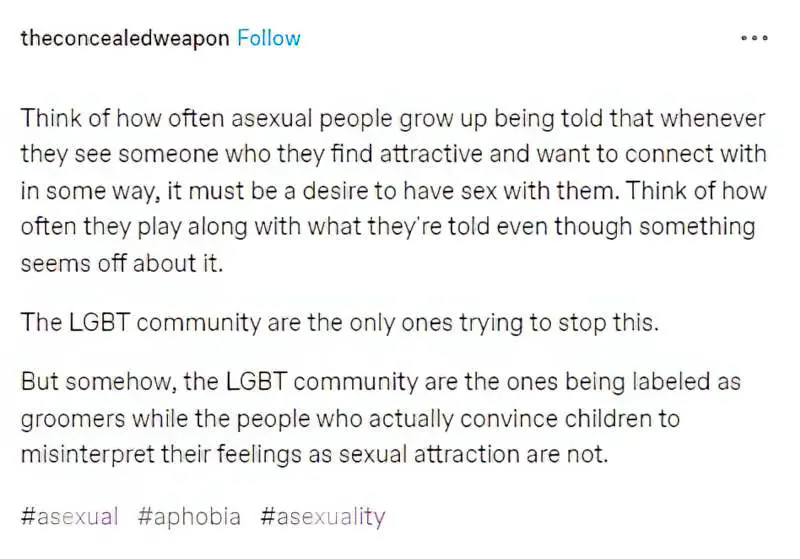
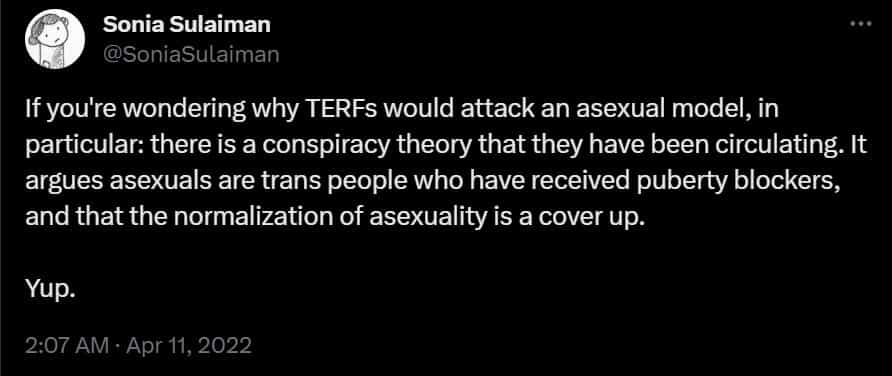
Sherronda J. Brown understands where the thinking comes from. Basically:
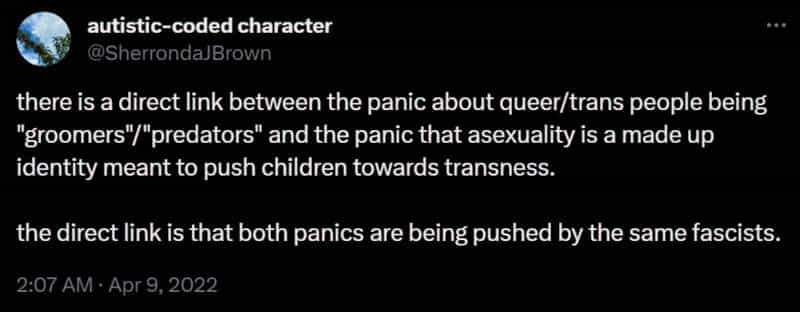
- They use the same language of “hormones” and “sexual (dys)function” and “protecting children” to rage against the existence of trans people *and* the existence of asexual people, yet they lack any real understanding about what both of these identities encompass.
- The persistent ignorance of both transness and asexuality is by design. they have no intention of learning about these identities. all they care about is the fact that these are queer identities, and they hate anyone who isn’t cis and straight.
- And the link between their hatred of transness and asexuality is just pure ableism. because the dominant idea of “health” is a figment of the white supremacist colonial imagination. anything outside of “normal” cisheterosexuality will always be considered “unhealthy” to fascists.
- And when something is framed as “unhealthy,” it’s socially acceptable to rally against it. we can’t have children thinking they can be anything other than the gender they were assigned, and we also can’t have them “choosing” not to participate in heterosexuality. that’s unhealthy
- It doesn’t matter that being trans or asexual has absolutely nothing to with one’s sexual function. fascists see anything outside of performing cisheterosexuality as a sexual dysfunction, and as an extension, a crisis of gender. because sexuality and gender are inseparable ideas.
People claiming asexuality as a cover for paedoph*lia is also a QAn*n talking point.
If you’ve read the books above, you’ll easily pick out the:
- Ableism (Autistics are not trusted to know their own minds. Sherronda J. Brown writes eloquently about that.)
- The general infantilization (It’s easy to feel empathy for this aspect… They’re denying to themselves). Julie Sondra Decker writes about infantilization in The Invisible Orientation.
- The ‘asexuals are liars’ trope. Anyone who says they’re asexual is really something else, e.g. gay. Using transwomen as peak victims of this, Julia Serano writes eloquently about who society chooses to believe. Black asexuals are even less likely to be believed than white asexuals regarding their own identities, as Sherronda J. Brown and also Yasmin Benoit have said. (Hear Yasmin interviewed on the Sensual Self podcast.)
- The conflation of asexuality and celibacy (the first is an orientation; the second a way of living). Julie Sondra Decker writes about celibacy in The Invisible Orientation, as this really is Asexuality 101.
- The continued medicalisation of asexuality. Many people write about this as the DSM was only changed after asexual activism. (The wording still isn’t great.)
- This gay psychologist admitting how he will do conversion therapy in his own office if he sees a client presenting as asexual (Asexuals experience conversation therapy at about 10% according to a Stonewall survey, second only to the trans community at 13%. The overall rate is 7% across the queer labels. Listen to The Ace Couple podcast for more on that.)
- Taking a historical figure embraced by the ace community and suggesting he wasn’t really asexual (because asexuality — on its own — does not exist — it is always a cover for something). (For an absolute butchery of Edward Gorey’s life, see Gorey’s main biographer, who spent over a decade writing an entire acephobic book without looking into what asexuality is.)
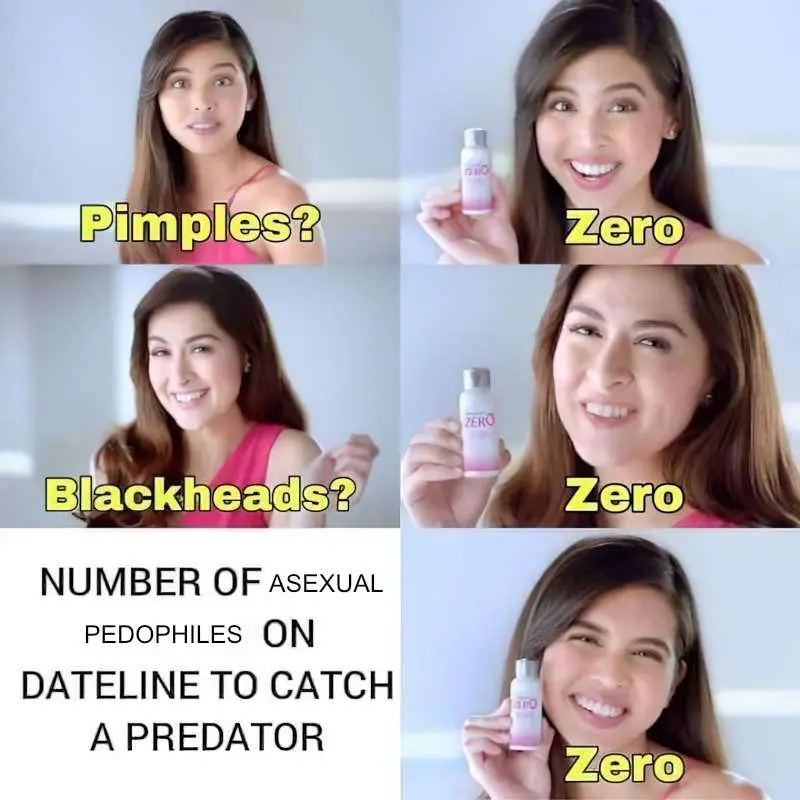
For Ace Readers
As you can see, it is not enough to seek out a queer professional. A psychologist may be deflecting their own trauma onto you, with the exact same talking points which were being hurled at gays and lesbians in the 1970s and 80s.
Here is the same doctor on Twitter musing over whether asexual conversion therapy counts as conversion therapy. Note that when this ‘hypothetical musing’ comes from a therapist with a PhD and a platform, it cannot count as ‘hypothetical’. Real asexual people find themselves in this guy’s office, paying him money for this:
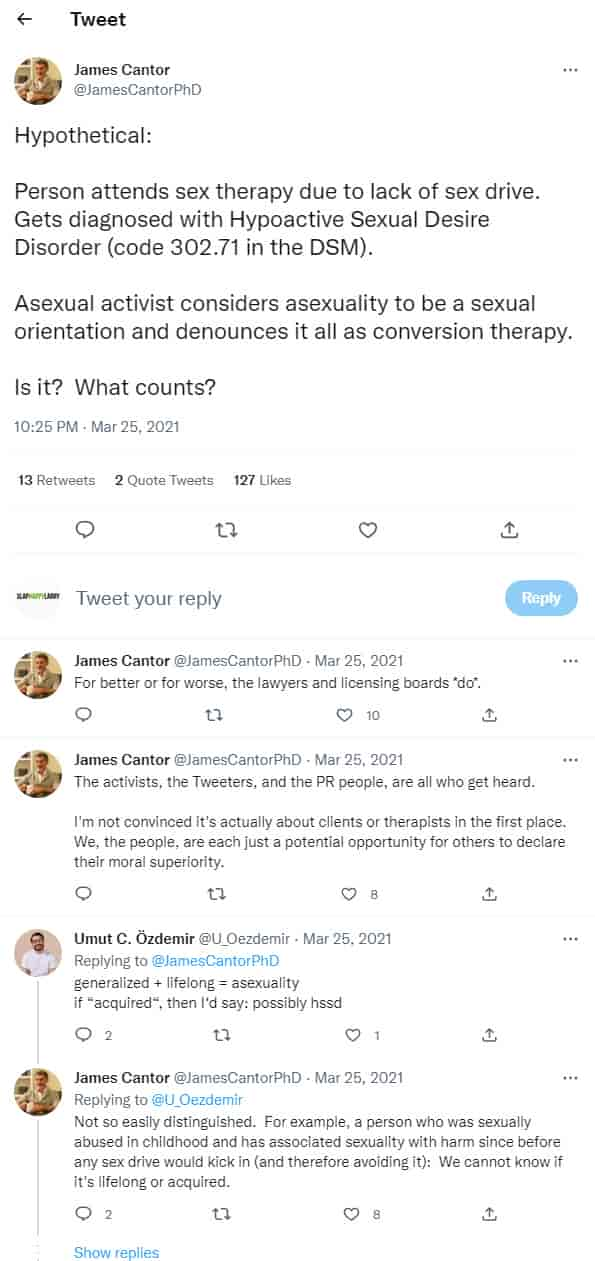
If he would only replace ‘asexual’ with ‘homosexual’ he might finally get it, except the sticking point is this: James Cantor does not consider asexuality an orientation worthy of respect. Note that he does seem to consider asexuality an orientation. That’s because Cantor has a broad definition of the term ‘orientation’, and also considers paedophilia an orientation (unchangeable, lasting), though in need of heavy management and destigmatization, which — to be clear — is not the same thing as normalisation. He would like to see paedophiles receive non-judgemental treatment before they offend. A convincing argument.
That said, using Dr Cantor as prime example, convincing the world that asexuality is an orientation (not a mental illness, not a trauma response etc.) will not fix the problematisation. Asexual orientations are lumped in with paedophilia, here parsed as ‘paedophiles under cover’.
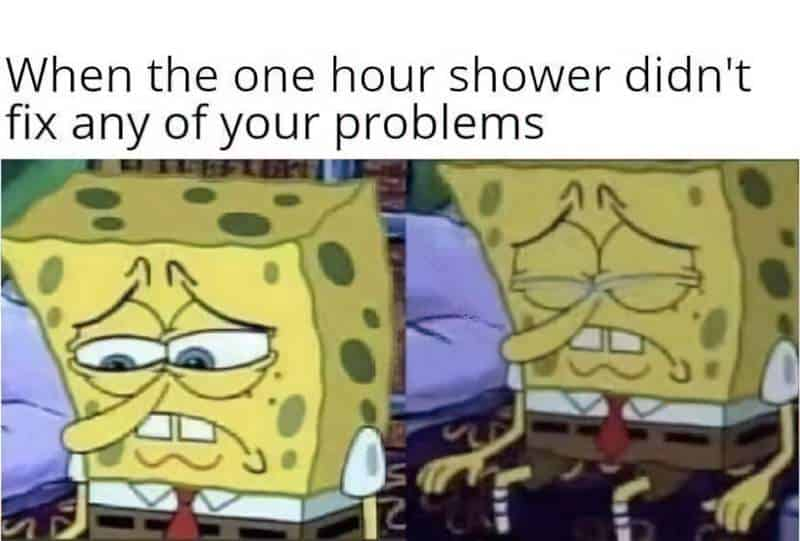
If you are asexual yourself, be ultra careful when seeking out professional psychology and counselling services. First, call a local queer outreach community, then ask to speak to an asexual volunteer. Failing that, speak to a trans person, who probably knows plenty of aces in the local trans community. There are many overlaps between the trans and ace communities regarding the bigotry both groups face, completely aside from the fact that many aces are also non-binary/trans as well. Ask them for recommendations lest you accidentally find yourself face-to-face with a Cantor accolyte.
Asexuality and Autism
The best Autistic asexual voices out there that I have found so far:
- The Ace Couple podcast
- Sherronda J. Brown’s book
Both of these resources go beyond Asexuality 101.
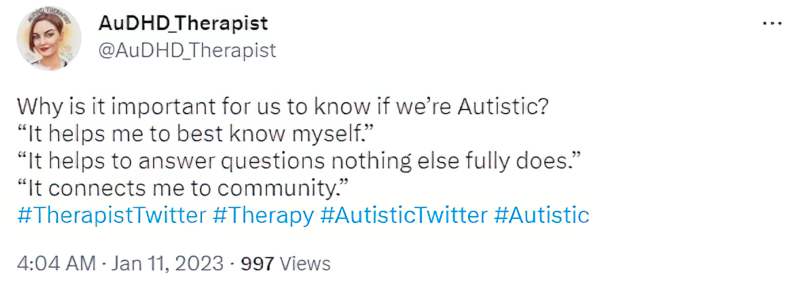
However, it would seem the majority of so-called sex experts out there are lucky to have made it to the 101.
I’m still waiting for a non-fiction text specifically on the intersectionality between asexuality and autism. Unfortunately, asexual activism can devolve into ableist language by insisting that “there’s nothing wrong with our bodies; we are not broken”. In turn, the autistic community is very keen to avoid the very real problem of desexualisation.
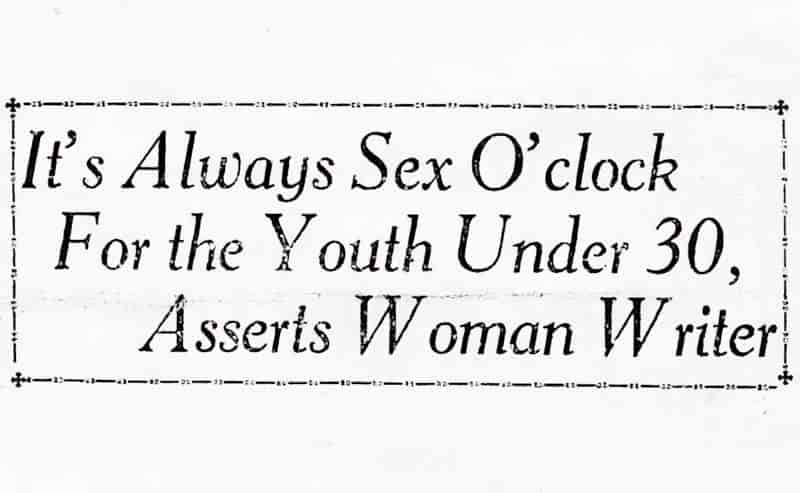
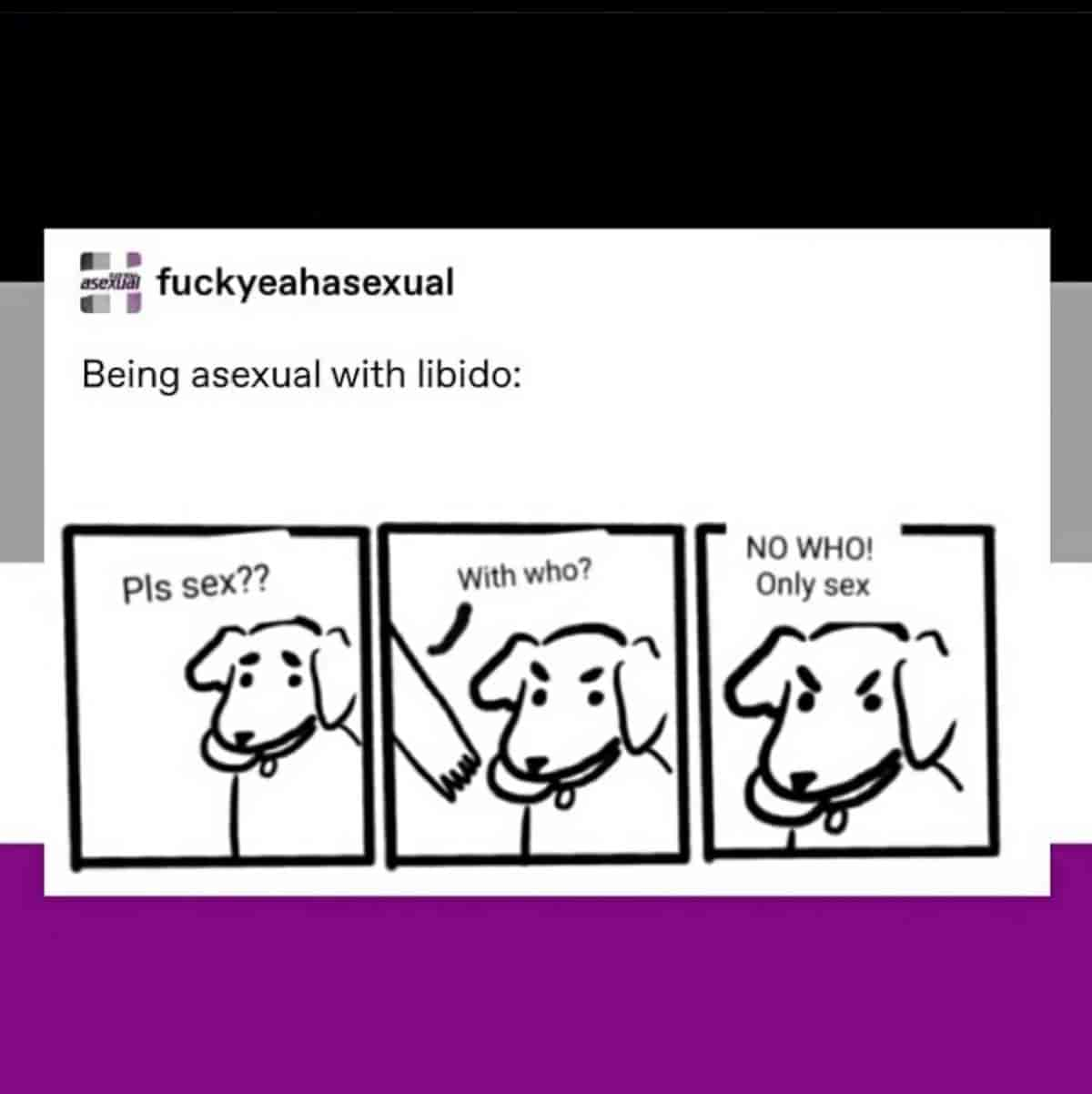

FURTHER READING
On Being Queer and Happily Single — Except When I’m Not by Brandon Taylor at Them.Us.
The ace community has contributed many terms to LGBTQIA+ dictionaries, which angers some people. But “new” terms to describe old concepts are not “newspeak”.
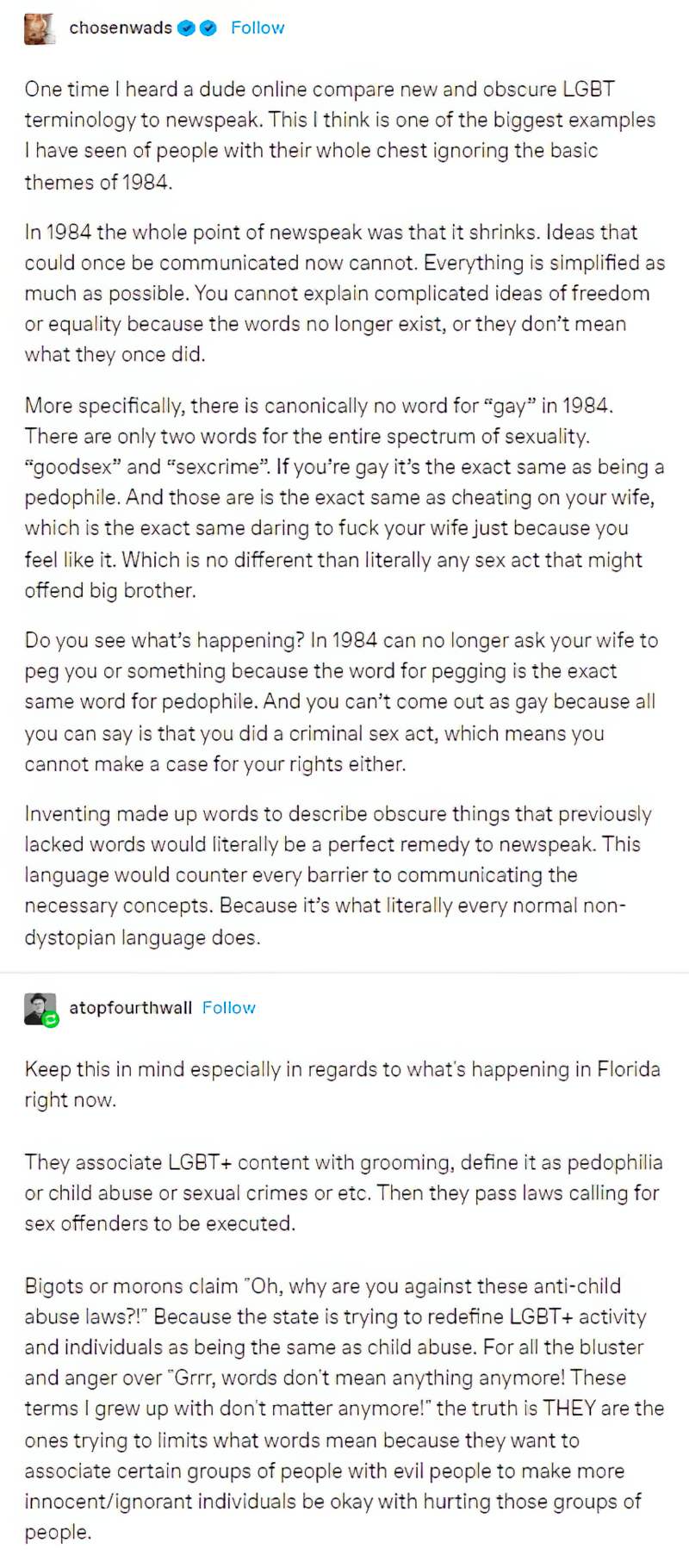
Compared to my autism diagnosis, coming to terms with being ace was much scarier.
…
Both autism and asexuality challenge what our patriarchal, ableist society deems acceptable.
How getting diagnosed with autism helped me embrace my asexuality
